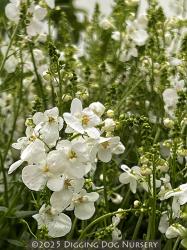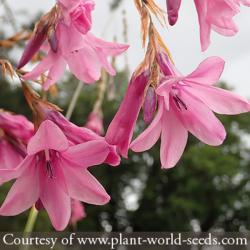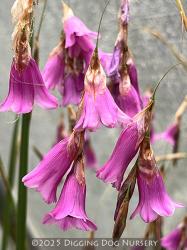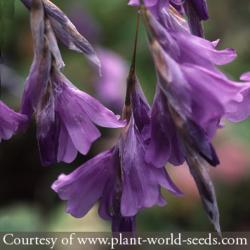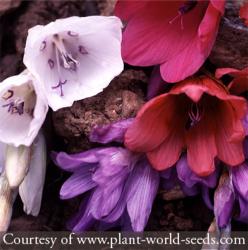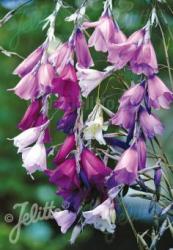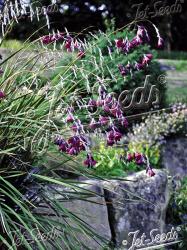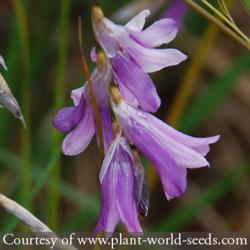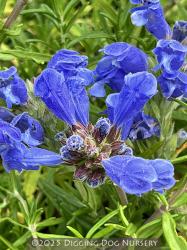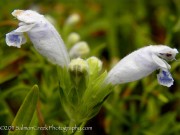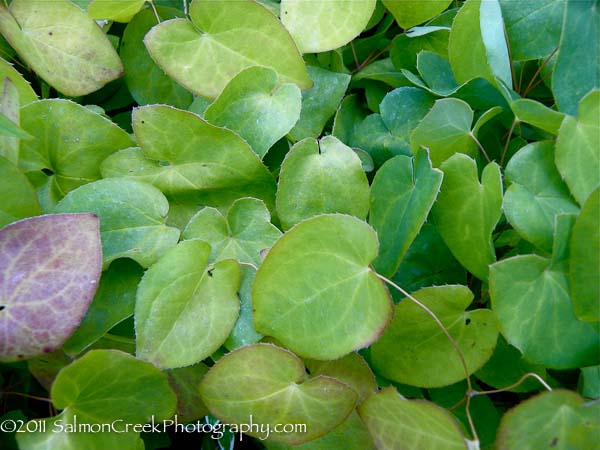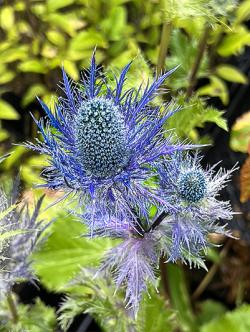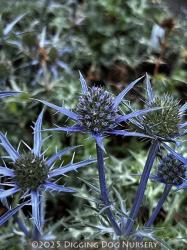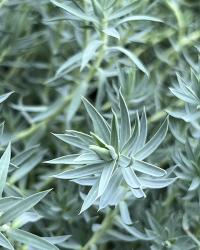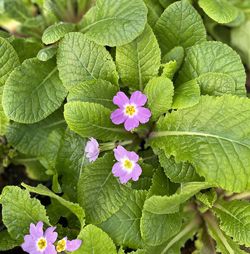Including Dianthus, Diascia, Digitalis, Dierama, Eryngium, & Eupatorium
Dahlia
Cultivated by the Aztecs before Cortez’s arrival, introduced to Europe in 1784 and named after Andreas Dahl, a student of Carl Linnaeus, these Mexican and Central American natives have a fascinating past. Promising stylish pizazz for today’s landscape, the following new Dutch introductions stem from the widely popular “Bishop” series, which originated in the 1920s.
Long blooming and fantastic as cut flowers, Dahlias favor moist well-drained bright abodes and require deadheading, regular feeding and frost protection. If the tubers are grown in a garden bed, they should be lifted and dried before the first hard freeze, stored throughout the winter and planted outside after frosty nights have subsided, or remain in sheltered containers until warmer weather arrives.
Dahlia ‘Bishop of Llandaff’ (P-1956)
Each $11.75
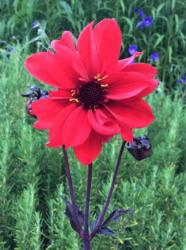
Opulent color is this glamorous Dahlia’s calling card. Like a cherry-laced dark chocolate bar, ‘Bishop of Llandaff’ seduces us with lavish Peony-like dark red blooms above a sumptuous strong growing mound of deeply lobed, dark bronzy purple foliage. Surround with Kniphofia ‘Bee’s Sunset’ or Crocosmia ‘Mistral’ and a summer-time celebration of sizzling flowers are yours for the viewing.
Blooms July–October
Size: 3' 0" high x 12" – 16" wide.
Zone 7b/8.
Inclusive to the Dutch Bishop series, this must-have, Paeony-style Dahlia sprouts mahogany-colored stems dressed with pinnately divided raisin-purple foliage. Multitudes of single, 4 in. coppery orange flowers unfurl for months, casting a bodacious splash upon the rich glistening foliage. ‘Bishop of Oxford’ can be premiered in terra cotta pots, mixed plantings and cottage gardens, while its flashy aspect entices florists, pollinators and daring gardeners.
Blooms July–October
Size: 3' 0" high x 12" – 16" wide.
Zone 7b/8.
Dahlia ‘Bishop Of York’ (P-1799)
Each $11.75
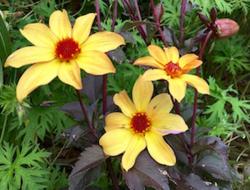
Flaunting the same sensuous purplish black-flushed foliage as our other “Bishop” series selection, this vigorous Dahlia’s upright and compact leafy clump becomes a rich dark backdrop for perfectly round bright yellow flowers infused with a touch of orange. A one-man show, ‘Bishop of York’s dynamic contrasting colors inject compelling accents to a container, cottage garden or a more formal venue.
Blooms August–September.
Size: 3' 0" high x 12" – 16" wide.
Zone 7b/8.
Dianthus
Garden Pinks
The subtleties of the Dianthus we’ve selected will take you back to Roman times, when this plant was regarded as divine, “Jove’s Flower.”Throughout history, clove-scented Dianthus have been cultivated for their fragrance and essential oils. Easy to grow and steadfast in well-drained soil, Dianthus, with neat mounds of linear blue, green or gray-green foliage, are an ageless addition to any garden, especially suited to seasoned habitats such as the rockery, walls or stone pathways.
Dianthus ‘Bridal Veil’ (P-1512)
Each $11.00
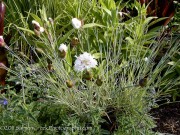
Another dazzling Dianthus whose popularity has endured since the 17th-century, ‘Bridal Veil’ stays true to her name with ornate, highly fringed double white flowers. Speckled, deep carmine-colored centers are as plush as velour and ignite the crisp snowy blooms that offer up such a sweet and strong perfume, while adorning low, narrow-leafed gray-green tumps.
Blooms July – August.
Size: 12" high x 12" wide.
Hardy to zone 6.
Dianthus carthusianorum (P-1102)
Each $11.00

Hailing from the alpine meadows of central and southeast Europe, this tall growing Dianthus begets small, deep magenta blooms. Narrow, grassy green foliage comprise the long lasting rosettes, which send up wiry, and nearly leafless, bluish stems. Crowning the lengthy stalks, little tufts of reddish brown calyxes cradle six or more vividly tinted flowers enhanced by fringed petals.
Happiest in dry sunny sites and alkaline soils, this sprightly perennial brings cheery color to a naturalized planting of grasses.
Blooms July–September.
Size: 2' 0" – 2-1/2' high x 10" – 12" wide.
Hardy to zone 5.
Dianthus ‘Charles Musgrave’ (P-0054)
Each $11.00
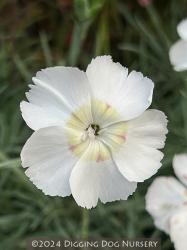
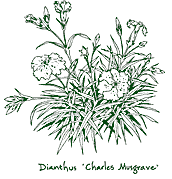
Charles hit the jackpot with this cultivar; perfect pure white with the most unusual green eye and a spicy perfume. Pair with Lavenders. Bring on a second bloom by trimming back its silver-gray foliage and spent stalks after the first flowering.
Blooms May–July
Size: 10" high x 12" wide.
Hardy to zone 5.
Each $11.00

Cultivated in Scotland since the 1700s, migrating to the Pacific Northwest via Scottish immigrants and finally rediscovered in a Seattle garden, this old-time enchantress has an intriguing heritage. ‘Gloriosa’s pale pink flowers were once described by British garden writer, Roy Genders as possessing “a fully double, beautiful shape with an outstanding fragrance.” Dark red eyes enhance the floral splendor perched just above a tidy, low growing blue-green mat that’s both hardy and vigorous.
Blooms July – August.
Size: 12" high x 12" wide.
Hardy to zone 5.
Making its garden debut in the 1700s, ‘Inchmery’ is still the epitome of delicacy today. The long linear buds appear in late spring and are heightened by a deep maroon stripe around each base. Poised atop bluish green tumps, fragrant shell-pink double blossoms harmonize with Lavandula ‘England’ and Helianthemum ‘Wisley Primrose’.
Blooms July–August
Size: 12" high x 12" wide.
Hardy to zone 5.
Dianthus ‘Mendlesham Frilly’ (P-0739)
Each $11.00
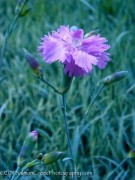
Aptly named, ‘Frilly’s semidouble flowers are just that, bright pink with fringed petals and a dainty look. Sue and Peter Russell of Mills Farm Plants in England bred this cultivar as one of their highly successful ‘Mendlesham Series’, a group of Dianthus selected for neat, compact form, demure appearance, intense fragrance, and repeat bloom.
Blooms June–September.
Size: 9" high x 15" wide.
Hardy to zone 5.
The lavish, richly pink, semidouble blossoms bred into this cultivar by Sue and Peter Russell burst forth almost continuously throughout its long blooming season. Particularly neat blue-green narrow foliage mounds nicely; show it off at the front of the border or, for a fragrant delight, plant with Lavandula ‘Richard Gray’.
Blooms June–September.
Size: 8" high x 12" wide.
Hardy to zone 5.

Snow white, semidouble flowers sparkle with a classic elegance above a handsome tussock of blue foliage. The first cultivar in the Russells’ impressive ‘Mendlesham Series’, this sweetly fragrant maid will look exquisite in your favorite container.
Blooms June–September.
Size: 8" high x 12" wide.
Hardy to zone 5.
Dianthus ‘Nancy Lindsay’ (P-0788)
Each $11.00
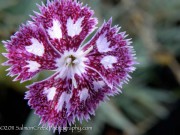
Liberated from the namesakes’ garden following her demise, this age-old British treasure offers a lavish floral pageantry. Pearly eyed flowers show off deep carmine petals, each donning pinkish white fringes, 2 irregular snowy flecks and minute, magenta speckles that glisten in the morning light. ‘Nancy’s dainty flowers dress up her tidy, glaucous blue tussock and fill the air with an irresistible spicy perfume.
Blooms July–August
Size: 9" high x 12" wide.
Hardy to zone 5.
Each $11.00
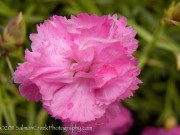
Trimmed with fringed rosy mauve petals, quantities of open-faced semidouble blossoms exude an enticing clove aroma. Spotted in England by Alan Bloom, ‘Oakington’s densely sculpted, low blue-gray tufts look good nearly year round and can be nestled alongside Achillea x kellereri or Thymus praecox ‘Albus’ for an intriguing foliar tapestry.
Blooms July – August.
Size: 8" high x 12" wide.
Zone 5/6.
Dianthus ‘Pheasant’s Ear’ (P-0637)
Each $11.00
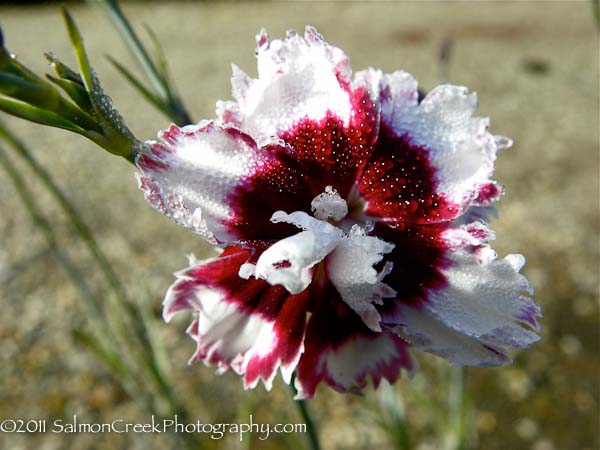
This old cultivar, dating back to 1690, is named for the tuft in the center of the flower, which was thought to represent a pheasant’s ear. The semi-double white flowers are strongly scented and fringed with the same deep burgundy color as the centers. We think its stunning blooms, tidy mounding habit, and fine blue-hued foliage will make this prolific bloomer a favorite for centuries to come.
Blooms May–June.
Size: 9" – 12" high x 14" wide.
Hardy to zone 5.
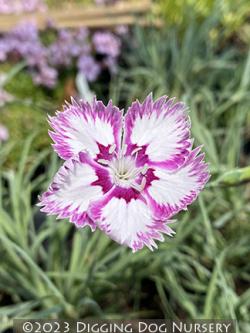
‘Queen of Sheba’s intricately patterned beauty has reigned in gardens since the early 1600s. Cresting a courtly frosted green clump, the single blooms present fringed rosy-red petals, each with a central pearlescent splash and a heady perfume. Most likely parented by Dianthus plumarius, this vintage Dianthus promises plush accents for a container display or a stone wall.
Blooms May–July
Size: 8" – 10" high x 8" – 10" wide.
Hardy to zone 4.
Dianthus ‘Rose de Mai’ (P-1833)
Each $11.00

The delectable clove-scented barrage of long-lasting 2 in. wide double blooms inspired American Dianthus aficionado, Mr. Rand Lee, to place ‘Rose De Mai’ at the top of his all-time favorite Gillyflower list. Endowed with an easy-to-blend clear-pink floral color, the lovely fringed display is staged well above narrow leafy stems and sturdy silver-laced, blue-green foliage. It appreciates an occasional trim and promises to soften any garden path or rock work, enduring drought plus difficult clay sites.
Blooms May–August
Size: 12" – 18" high x 12" – 18" wide.
Hardy to zone 3.
Dianthus spiculifolius (P-1330)
Each $11.00
Endemic to Europe’s Carpathian mountains, this low growing Dianthus is tailor-made for the rockery. A dense and compact blue-green cushion defined by prominently pointed, linear foliage elevates the wispy, scented cloud of white bearded flowers.
Lacy petals are inscribed at their bases with singular burgundy bands, forming a richly colored ring that centers each fringed celestial bloom.
Blooms May–August.
Size: 8" high x 12" – 15" wide.
Hardy to zone 6.
Each $11.00
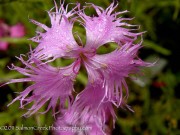

Its Japanese name, ‘Nadesiko,’ translates to “pretty girl” or “child,” and we couldn’t agree more! Grassy green tufts of narrow evergreen leaves set the stage for the deliciously fragrant, ethereal flowers. Feathery and fringed, the five-petaled, green-eyed blooms, colored in soft pinkish lavender hues, grace long but sturdy branched stems that emerge in a relaxed fashion before ascending.
Provide this enchanting, easy-to-cultivate Pink a cool spot with rich, well drained soil, and a multitude of lacy, loose floral clusters is yours to enjoy all summer long.
Blooms June–August.
Size: 12" – 15" high x 2' 0" wide.
Hardy to zone 5.
Dianthus ‘Sweetheart Abbey’ (P-2127)
Each $11.00
Paying homage to Scotland’s bygone years, this sweet smelling Dianthus is distinguished by lavish layers of crimson-colored petals with showy saw-toothed lilac margins. The well-endowed double flowers bejewel an appealing low mound of slender bluish green foliage that can be featured near the front of a border with companions such as Alchemilla alpina and Geranium ‘Mavis Simpson’.
Blooms May–July
Size: 10" – 15" high x 12" – 18" wide.
Hardy to zone 6.

A spectacular 17th-century cultivar, this handsome compact Dianthus is one of the rarest of old pinks. Stunning, frilled single flowers are so richly colored they look like velvet, the pink center set off by glowing red and dark crimson markings and deep pink feathering. The look is matched only by the delicious, almost intoxicating, clove fragrance. For an opulent blend of colors, plant with Lobelia ‘La Fresco’ and Schizachyrium.
Blooms July–August.
Size: 8" high x 14" wide.
Hardy to zone 5.
Diascia
TwinSpur
These increasingly popular South African perennials are good-looking, vigorous and quick to fill out. The long blooming cloud of pink to peach to lavender-colored flowers make these gracefully spreading plants perfect for containers.
Diascia ‘Blackthorn Apricot’ (P-0189)
Each $10.75

The striking color of these good-sized flowers will remind you of delicious summer peaches. Held about 6 in. above the fine dense mat of dark green foliage, they blend beautifully with Nepeta ‘Kit Kat’ and Scutellaria ‘Moonbeam’. Take advantage of this cultivar’s vigorous growth in a rock garden or in the front of a border with Eucomis ‘Sparkling Burgundy’ and Salvia sinaloensis.
Blooms April–October.
Size: 12" high x 2' 0" wide.
Hardy to zone 8.
‘Blue Bonnet’ forms a compact mound of slender, dark green, glossy triangular foliage that gracefully softens the edge of our garden path. The unique blooms are quite painterly: pink infused with blue, like a watercolor portrait, and highlighted by a cluster of bright yellow stamens.
Blooms June–September.
Size: 8" high x 2' 0" wide.
Hardy to zone 8.
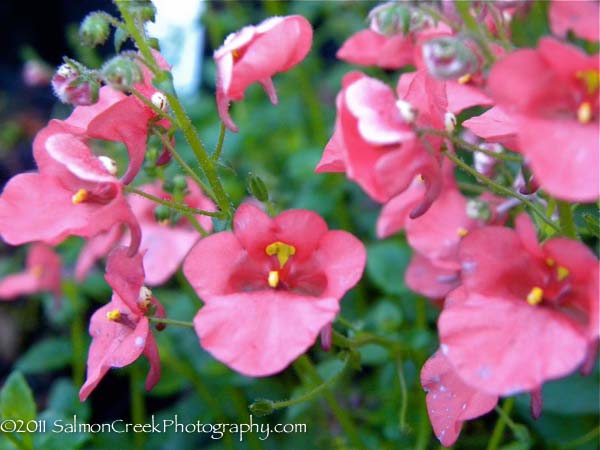
Highly saturated coral pink spurred flowers, each adorned with a yellow spot on its upper petal, are held gracefully above a tidy mound of handsome broad leaves. For elegant contrast in foliage and form, pair with Schizostylis ‘Alba’.
Blooms May–mid-October.
Size: 12" high x 2' 0" wide.
Hardy to zone 8.
The pearly blooms of this recent British selection herald an exciting new color within the Twinspurs. Arising from close-knit, grayish green linear foliage, the wiry 18 in. stems display myriad flowers that open with pinkish hints, and soon pale to nearly white. Let ‘Blush’ colonize a well drained spot atop a stone wall, where its carefree stance brings charm to such plants as Dracocephalum ‘Fuji Blue’ and Antirrhinum sempervirens.
Blooms June – October.
Size: 18" high x 18" & spreading wide.
Hardy to zone 8.

An inspiring new breakthrough selection discovered in South Africa’s Drakensberg Mountains, this tough Plant Select introduction broadens the hardiness range of the genus, exhibiting exceptional tolerance to both hot and cold temperatures. From spring until frost, upright fine textured green foliage bolsters an abundance of coral-pink wands, brimming with luscious flowers enhanced by darker pink centers. A stalwart beauty that easily graces an array of garden settings, ‘Coral Canyon’ can be planted next to Kniphofia pauciflora and Phygelius ‘Moonraker’.
Blooms June–October
Size: 15" high x 18" wide.
Hardy to zone 5.
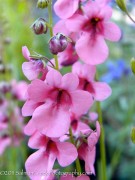
Evoking images of New Mexico’s plastered adobe walls, the uniquely colored, pale salmon pink flowers with maroon throats offer a head turning, nonstop display for months on end. Relaxed stems clad in needle-like green foliage form a tightset, deep green mound that is reliably cold hardy. Originating from a group of seedlings at High Country Gardens, this sturdy, small-sized gem appreciates a midsummer trim and rich garden soil.
Blooms June–October.
Size: 15" high x 18" wide.
Hardy to zone 5.
Diascia ‘Langthorns Lavender’ (P-0354)
Each $10.75
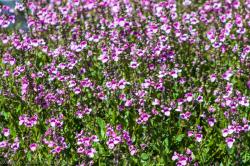
Rosy purple masses of small comely blossoms and linear narrow green leaves set this low growing charmer apart from the more commonly known pink and apricot blooming Diascias. ‘Langthorn’s Lavender’s diminutive form can be tucked along the front of the border or into a crevice, where its perky summer-long floral parade, riding atop upright stems, makes a delightful color echo with the plumes of Astilbe c. ‘Pumila’.
Blooms June–October
Size: 8" – 12" high x 12" wide.
Hardy to zone 8.
Diascia barberae ‘Trinity Grace’ (P-2332)
Each $10.75
Dicentra
Bleeding Heart
Treasured by all who behold them, Bleeding Hearts are ideal for the front of a border or a more relaxed setting such as a cottage garden or wildflower planting. These easily cultivated perennials appreciate ample shade during hot summers and flourish in well-drained humus-rich soil that’s not too wet.
Famed German plant breeder Ernest Pagels masterminded this stylish union of the eastern U.S. native, Dicentra eximia and our western native, Dicentra formosa. Deeply dissected, powdery blue-green foliage sends forth a generous showing of foot-tall stems laden with pendulous white flowers that reside well above the foliage. Irresistible to hummingbirds and bumblebees, ‘Aurora’s refined prowess touts vigor, bountiful blooms, deer resistance and superb winter hardiness, while casting luminous highlights in a lightly dappled and somewhat moist perennial border or woodland setting.
Blooms April–mid-June
Size: 10" – 15" high x 12" wide.
Hardy to zone 5.
Selected from our Pacific coast species, ‘Bacchanal’ sprouts an elegant filigree-like mound of deeply cut gray-green foliage. The sumptuous, velvety wine-red flowers are draped like romantic heart-shaped lockets, festooning lithe, arching stems. Reliable, energetic and long blooming, this urbane compact cultivar delights bees, begs moist niches and looks best when massed in shady borders or along wooded paths.
Blooms April–May
Size: 12" high x 12" wide.
Hardy to zone 4.
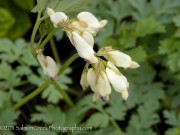
With charm to spare, alabaster heart-shaped “lockets”, each inscribed by a small pink mark gracefully dangle from pendulous, branched sprays atop a soft-looking ferny hummock. This choice evergreen perennial easily naturalizes given a cool moist location, the fernlike delicacy of its deeply divided, smoky blue leaves belying their vigor.
Unparalleled in the shade garden, ‘Margery Fish’ becomes summer dormant when the soil is too dry, can be planted as a lacy counterpoint to Tiarella ‘Mint Chocolate’ or cut for a sterling addition to a bouquet.
Blooms April–May & again in fall.
Size: 10" high x 12" wide.
Hardy to zone 5.
Dicentra spectabilis ‘Gold Heart’ (P-1647)
Each $13.25
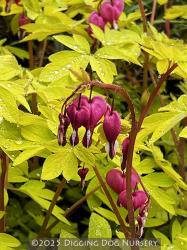
Hailing from the Pope’s Hadspen Gardens in Somerset, England, this Dicentra’s artful golden mounds of dissected ferny leaves will light up the shady corners of your garden. Nodding heart-styled rose-pink flowers line long, one-sided arching racemes above spectacular glowing foliage that is more yellow in bright shade and transforms to lime green in deeper shade. ‘Gold Heart’ can be massed with white-flowering Brunnera ‘Mr. Morse’ and Anemone ‘Snow Angel’ for sparkling color and contrasting foliar textures.
Blooms April–May
Size: 18" – 2' 0" high x 2' 0" – 2-1/2' wide.
Hardy to zone 4.
Paying tribute to the astute Berkshire-based alpine plantsman and author, this resilient AGM winner most likely arose from a Dicentra exima and Dicentra formosa cross. Copious arching sprays adorned with romantic deep rosy-pink floral hearts lounge above the snug, finely divided ensemble of slender lobed gray-green leaflets. A reliable lush-looking perennial, ‘Stuart Boothman’ can be planted amid Pulmonaria ‘Benediction’ or Hakonechloa macra in cottage gardens and mixed borders or beneath shrubs, where it blooms for months, thwarts bunnies and deer and adores consistent moist soil plus protection from hot afternoon sun.
Blooms April–July
Size: 8" – 15" high x 12" – 18" wide.
Hardy to zone 5.
Dierama
Fairy Wand Flower
This spectacular little-known corm comes from South Africa and augments just about any design situation, especially when it can be viewed from below. Surprisingly tough and undeniably enchanting, Fairy Wands withstand coastal winds and fairly low temperatures, while preferring good drainage.
Aptly named ‘Autumn Sparkler’s singular statement is its glowing lilac-pink blooms, which are positioned in a unique upward-facing, nonpendulous manner, appearing in the autumn long after others in the genus have dwindled. Embellished with uncommon eye-shaped markings at the base of each petal and looking a bit like an Ixia, the somewhat open, close-set flowers become an easy-to-view beacon of late season loveliness on taut erect wands. A coveted, rare plant found only in the small South African region known as Ngome, this Dierama’s tidy compact clump deserves a protected, well-traveled haunt.
Blooms August–October
Size: 3' 0" high x 2' 0" wide.
Hardy to zone 7.
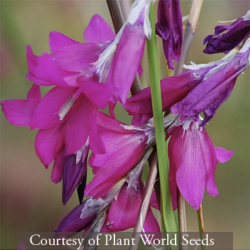
A richly hued hybrid most likely parented by Dierama ‘Cosmos’ and Dierama robustum, this vigorous Dierama sprouts tough, slender, grass-style foliage plus fine fishing rod-like stems adorned with deep purple-maroon flowers. Stage the dainty drooping panicles of flared trumpet-shaped blooms waterside and watch the slightest breeze set them in motion.
Blooms June–August
Size: 3-1/2' – 4-1/4' high x 3' 0" – 4' 0" wide.
Hardy to zone 7.
Dierama ‘Blood Drops’ (P-2315)
Each $12.00
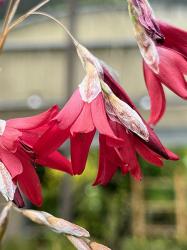
Recently discovered at Britain’s Plant World Seeds, this stand-out chance seedling forges a tall and mighty semi-evergreen clump. The attractive sword-shaped green leaves give way to nimble curved stems hosting fanciful laden clusters of pendent bell-like blooms with flared carmine-colored petals and tissue-thin frosted calyxes.
Splendid in containers, near pools, atop garden walls or as a specimen in mixed borders, ‘Blood Drops’ enjoys bright, adequately moist, well-drained abodes plus protection from cold winds and frosty nights.
Blooms June–August
Size: 3' 0" – 4' 0" high x 2-1/2' – 3' 0" wide.
Hardy to zone 7.
Deemed the darkest of the dark, this sought-after Dierama dazzles with draped flared bells bathed in seductive midnight-purple and burgundy shades, furnishing a dramatic contrast against papery silver-frosted bracts. Long-lived grassy evergreen blades plus curved fishing-pole-like stems anchor the sumptuous display. Included in Noel Kingsbury’s top-13 Dierama picks, ′Cosmos′ can be admired atop a retaining wall for easy viewing and skirted by lower growing plants such as Carex texensis and Nepeta ‘Snowflake’.
Blooms June–August
Size: 2-1/2' – 3-1/3' high x 2' 0" wide.
Hardy to zone 7.
OUT OF PRODUCTION AT THIS TIME
Email me when this plant is available
Thin stems gracefully bow from the weight of pretty, pendulous pale pink to bright magenta flower bells that gather towards the tips. Decorative open blooms with curved back petals dress up a low growing, narrow bladed tuft. Inhabiting higher altitudes, this species possesses a welcome fortitude for slightly colder temperatures.
Blooms June–August.
Size: 20" – 2' 0" high x 12" wide.
Zone 6/7.
Dierama dracomontanum (P-0639)
Each $12.00
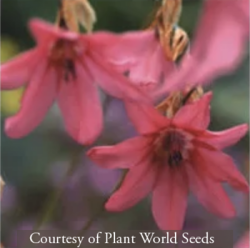
Indigenous to South Africa’s Drankensberg Mountains, at elevations often over 8000 ft., where it’s known to cover entire slopes, this cold-hardy evergreen Dierama is small on stature, but big on flower power. Graceful arching stems leap from a snug grassy green clump, while premiering a pendant bee-friendly plethora of flared bell-like flowers with pointed tepals that range in color from rosy mauve to salmon-pink. Recommended by Noel Kingsbury in his recent article about Dieramas, Dierama dracomontanum′s diminutive fine-textured habit can be nestled between rocks or staged in a sunny border′s frontlines alongside Nepeta reichenbachiana and Stachys ‘Densiflorus’
Blooms June–August
Size: 2' 0" – 3' 0" high x 2' 0" – 3-1/2' wide.
Hardy to zone 7.
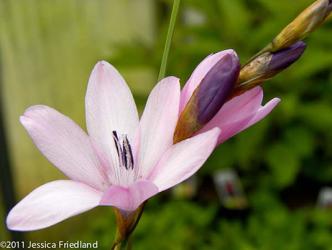
Indigenous to South Africa’s open grasslands, this vigorous Dierama sports a smaller stature than Dierama pulcherrimum. Slender blade-like green leaves boost a wealth of pendulous, wide-flaring lilac to rosy-pink flowers that lend a lighthearted charm wherever they unfurl.
Blooms July–September
Size: 3' 0" high x 2' 0" wide.
Hardy to zone 7.
Narrow evergreen blade-like leaves, supple slender stems and silver-laced papery calyces set the stage for a beguiling floral display of pendent fairy-style bells suffused in deep lavish blackberry shades. Position ‘Merlin’ against a golden-leafed or steel-hued backdrop, supply well-drained soil with adequate summer water and enjoy the magic.
Blooms June–August
Size: 3' 0" high x 2' 0" wide.
Hardy to zone 7.
With fairy-tale appeal, ample-sized bright lilac blooms are suspended from sturdy arching stems. Vigorous grass-like foliage maintains a relatively low profile beneath the bounty of flared flowers.
Blooms June–August
Size: 2' 0" high x 2' 0" wide.
Hardy to zone 7.
The splendid, narrow pink flowers and papery, pearlescent calyces are clustered on strong, yet ultrathin nodding stems above low slender foliage. One of the earliest Dieramas to bloom, this delicate looking dwarf evergreen species is a comely candidate for the rockery, a patio container or small-scale settings.
Blooms June–August
Size: 2' 0" – 3' 0" high x 4' 0" – 5' 0" wide.
Hardy to zone 7.
Each $12.00
Arising from tall clumps of upright, grasslike blades, graceful curving canes display pendant and wide-flaring, purplish pink flowers. This Dierama’s profusion of charming, bell-shaped blossoms can be coupled with yellow blooming Phygelius ‘Moonraker’ for a festive effect.
Blooms June–August.
Size: 4' 0" – 5' 0" high x 4' 0" – 5' 0" wide.
Hardy to zone 8.
Even though ‘Alba’ is smaller than Dierama pulcherrimum, it has larger, white, more bell-styled flowers that brightly charm its thin supple stems, unusual chartreuse calyxes, and slender less flexible, more upright leaves. This nimble-looking evergreen can be nestled into paving cracks along a terrace or sited near a pool and is most extraordinary when backlit and planted en masse.
Blooms June – August.
Size: 4' 0" high x 3' 0" – 4' 0" wide.
Hardy to zone 8.
Dierama ‘Pink Rocket’ (P-2228)
Each $12.00
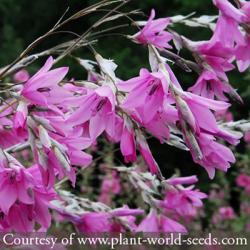
Introduced by Britain’s acclaimed Plant World Seeds, this new distinctive cultivar regales us with plentiful clusters of flared bright pink blooms. Unfurling in an unique outward or upward-facing fashion, the ornate fairytale flowers gambol above attractive narrow blades on copious sturdy and slender upright stems. A relatively compact Dierama erectum descendant, ‘Pink Rocket’s robust evergreen mound can be ensconced amid rock work or perched atop a staircase.
Blooms June–August
Size: 3' 0" high x 18" wide.
Hardy to zone 7.
Dierama ‘Plant World Jewels’ (P-2264)
Each $12.00
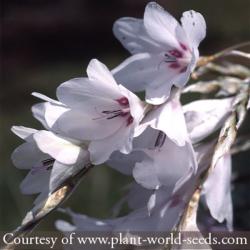
Draped in elegance, numerous arcs of narrow stems carry flaring crepe paper-like snowy-white bells. The nodding pearlescent flowers illuminate long strap-like deep green leaves that form a clumping evergreen base. Well-suited for gravel gardens, borders or raised beds, this spectacular white Dierama can be mixed with ornamental grasses or fellow South African denizens plus other perennials.
Blooms June–August
Size: 4' 0" – 5' 0" high x 4' 0" – 5' 0" wide.
Hardy to zone 7.

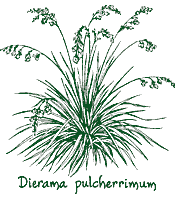
Like a kinetic sculpture in the wind, this Dierama’s elegant pink bellflowers dangle from strong, wiry stems that arch above its stiff, linear foliage. As a specimen against a darker background or on a slope, Dierama pulcherrimum will bring drama to your garden.
Blooms June–August.
Size: 4' 0" – 5' 0" high x 4' 0" – 5' 0" wide.
Hardy to zone 7.
Achieving a painterly aspect, each lovely pale pink bell features a darker brush stroke along its tips. Fishing pole-thin stems showcase the draped splendor above a mound of narrow blade-like leaves.
Blooms June–August
Size: 3-1/2' – 4' 0" high x 3-1/2' wide.
Hardy to zone 7.
Dierama pulcherrimum ‘Silver Dawn’ (P-0363)
Each $12.00
A study in delicacy, ethereal-looking pale pink flowers dangle from tall arching lean stems, appearing more bell-shaped and less flared than those of Dierama. pendulum. ‘Silver Dawn’s thick grassy evergreen clumps can grace the rockery or a raised bank with Salvia ‘Vatican White’ nearby.
Blooms June–August
Size: 4' 0" – 5' 0" high x 4' 0" – 5' 0" wide.
Hardy to zone 7.
Lithe stems elevate countless good-sized pure white bells that look a bit like a mesmerizing snow flurry. The pendent luminous flowers sashay above a Iris-styled clump of slightly stiff blade-like bluish green leaves.
Blooms June–August
Size: 4' 0" – 5' 0" high x 4' 0" – 5' 0" wide.
Hardy to zone 7.
Each $12.00
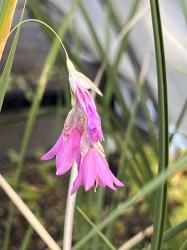
Named for Dr. G. W. Reynolds, an optician, Aloe authority and Dierama fan, this gorgeous Dierama was discovered in the higher elevation grasslands of the KwaZulu-Natal region on a 1832 collecting trip. Lengthy arching stems present the posh, 1 in. long dangling wine-red flowers, which are nestled amid white pewter-laced tissue-like bracts, boldly setting off the pointed tepals. Highly favored by plant designer Noel Kingsbury, Dierama reynoldsii′s upright, narrow-bladed 2 ft. tall clump imparts peerless enchantment to small containers, rockeries, cottage gardens and even cut creations.
Blooms June–August
Size: 3' 0" – 4' 0" high x 3' 0" – 3-1/2' wide.
Hardy to zone 7.
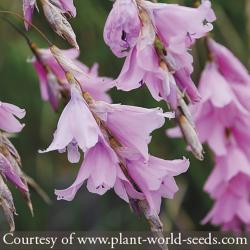
Exhibiting the grace of a dancer, its thin arching stems present pendulous, flared bells, ranging in color from milky white to mauve pink. One of the tallest Dierama species and quite hardy, the sizable clumps of imposing blades and dainty flowers look especially alluring in a container.
Blooms June–August.
Size: 5' 0" – 6' 0" high x 4' 0" – 5' 0" wide.
Hardy to zone 8.
Digitalis
Foxglove
Digitalis used to be called “Finger-flowers,” because its blossoms resemble the fingers of a glove with the ends cut off. Dwelling in deep hollows and woody dells, this poisonous herb grows easily in any fertile soil, seeds itself freely, and lends a naturalized look at the edge of the woodlands, especially when combined with Aruncus, Actaea or ferns.
Originally found on Krk Island off the Yugoslavian coastline, Rusty Foxglove boasts distinctive copper-hued columns of bloom. Lanceolate, dark evergreen leaves form a handsome base for the large tightly-packed, thimble-shaped flowers colored in cheerful yellows with rust accents. A powerful element in the garden or in an arrangement, let its stately stance echo the vertical blades of Calamagrostis, while blue Aconitum provides glorious complementary color. Readily reseeding, this intriguing biennial will bring years of enjoyment.
Blooms July–August
Size: 4' 0" – 5' 0" high x 12" – 15" wide.
Hardy to zone 6.
Digitalis grandiflora (P-0193)
Each $11.00
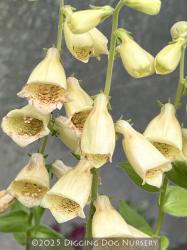
Meandering throughout the woodlands and stream banks of central and southern Europe to Turkey and western Siberia, this AGM recipient is touted as one of the hardiest and longest lived perennial species in the genus. Lanky lance-shaped leaves with fine teeth and prominent veins compose the handsome green rosette that launches a lovely pastel showing of pendulous creamy-yellow blooms. Set along one side of staunch, tall leafy stalks, the large funnel-shaped flowers reveal showy brown-stippled interiors; superimposed against a dark backdrop they create an impressive effect.
Blooms June–August
Size: 2' 0" – 3' 0" high x 12" – 18" wide.
Hardy to zone 3.
Digitalis x mertonensis (P-0195)
Each $11.00
This evergreen Foxglove is loved for its lush, velvety, dark green basal foliage. Its large flowers are tinged with rosy mauve and peppered with coppery sandstone. Divide after blooming to maintain as a perennial. Combine with Geranium ‘Langthorn’s Blue’ to make a bold statement.
Blooms July–August.
Size: 2' 0" high x 12" wide.
Hardy to zone 5.
Digitalis purpurea ‘Camelot Cream’ (P-2036)
Each $11.00
This remarkable long-blooming F1 hybrid delivers oodles of floral pomp. Laden with crimson-speckled cream-hued blooms, the reliable, well-endowed towering spires develop in the first year and yield a grander repeat performance the second. Large, nectar-rich pendulous bells densely stud 4 ft. tall, steadfast stalks above hearty dark green leaves. A choice contender for cottage gardens or bouquets, ‘Camelot Cream’ relishes prudent dead-heading and moist rich soil.
Blooms April–August
Size: 3' 0" – 4' 0" high x 18" – 2' 0" wide.
Hardy to zone 5.
Digitalis purpurea ‘Camelot Lavender’ (P-2178)
Each $11.00
Granted an AGM for its statuesque presence and dependable nectar-rich flower power, this Camelot Series member was introduced in 2003. Numerous lusty stems shoulder an extraordinary profusion of densely-set creamy-yellow buds that reveal funnel-shaped white blossoms with burgundy-speckled pale lavender interiors. Delivering a first-year bloom, followed by an even more floriferous performance the next year, ‘Camelot Lavender’s ample, somewhat fuzzy basal mound of oblong, big-leafed greenery can be positioned in containers or massed along a woodland’s periphery, where it grows as a biennial or short-lived perennial but does reseed.
Blooms May–July
Size: 3' 0" – 4' 0" high x 18" – 2' 0" wide.
Hardy to zone 5.
Tall stately spires grab our attention as closely arranged white buds morph into funnel-shaped creamy white blooms distinguished by deep maroon throats plus ruffle-edged tips with burgundy spots and splotches. Sprouting an attractive evergreen basal rosette of oblong medium green foliage, this perennial’s good-sized undemanding stature can grace a border, a cottage garden or more informal setting, while its ornate self-sowing flowers make a luminous statement against dark-leafed shrubs or hedges. Introduced by Wayside Gardens, ‘Pam’s Choice’ resists deer, lives longer if its blossoms don’t set seed and thrives in organic-rich moderately moist acidic spots that drain well.
Blooms May–July
Size: 3' 0" – 4' 0" high x 18" wide.
Hardy to zone 4.
'Silver Fox' flounces such a winning combination of soothing pastel colors, it’s hard to decide what is more lovely: the large white bells laced with pink on the outside and speckled with dark pink on the inside, or the lanceolate woolly silver foliage. Luring butterflies, gardeners and florists, the bounty of blooms crest multiple stems above an undemanding biennial habit that easily reseeds, fends off deer as well as bunnies and enjoys lime-free well-drained sites.
Blooms May–July
Size: 2-1/2' high x 12" wide.
Hardy to zone 4.
Digitalis purpurea ‘Snow Thimble’ (P-1104)
Each $11.00
Majestic spires of snowy white flowers rise above upright stems and attractive lanceolate leaves. Touted as the first seed strain of pure white blooms, this biennial Foxglove looks outstanding in a drift with Corydalis ‘Blue Panda’, and perpetuates itself by easily reseeding.
Blooms May–July.
Size: 3-1/2' – 4' 0" high x 18" wide.
Zone 5/6.
Digitalis purpurea ‘Sutton’s Apricot’ (P-0196)
Each $11.00
Vigorous and upright, this biennial cultivar is named for the large, pendulous apricot blooms that crowd its imposing, straight stems. The medium green leathery leaves are slightly wooly, large at the base of the stalk and smaller as they ascend.
Coveted by bumblebees, hummingbirds and gardeners alike, ‘Sutton’s Apricot’ dresses the garden in pastels and a carefree style.
Blooms April–June.
Size: 4' 0" high x 2' 0" wide.
Zone 5/6.
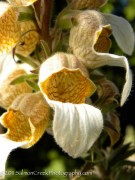
Linear stems, garbed in gleaming, darkly green lanceolate leaves with fine gray-haired margins, spring from a tailored evergreen rosette. Indigenous to Turkey, this hard-to-find Foxglove’s signature is its remarkable soft-looking, earthy flower spikes. Fuzzy, tightly set, silver-washed buds unveil caramel-colored blossoms, featuring elaborately patterned gold and rusty-brown throats plus white lips. Long blooming, more drought tolerant than other Digitalis and happiest in a cool, somewhat shady setting, it can be positioned next to Salvia forsskaolii.
Blooms June–August
Size: 2' 0" – 2-1/2' high x 12" wide.
Zone 5/6.
Disporum
Fairy Bells
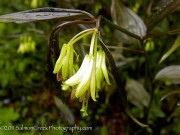

With a cultivar name that honors where it originated, Heronswood Nursery, and perhaps alludes to the majestic Black-Crowned Night Heron, this woodland treasure unfurls tall bamboo-style stalks and magnificent midnight-purple leaves. The polished evergreen clumps possess a straight-up, dignified and dark presence, offsetting spring’s myriad greenery. Deciduous in cooler climates, the foliage lines decorative stems marked by golden-tan paper-like bracts at each node, and lightens to a greenish purple when summer arrives. In graceful repose, the tips bow, revealing terminal clusters of small creamy-white bells, and later, abundant purple-black berries. A lover of rich moist locations, ‘Night Heron’ is easy to cultivate, gives its best show en masse and looks refined against Rodgersia aesculifolia’s broad foliage.
Blooms April–July
Size: 4' 0" – 5' 0" high x 3' 0" wide.
Hardy to zone 5.
Dracocephalum
Dragon’s Head
If you’re looking for something showy to infill cracks and crevices throughout the rockery, this long-lived charmer could be your choice. A virtually carefree perennial, Dragon Head’s handsome, dark green tidy mounds and terminal spikes of little Snapdragon-like flowers guarantee to captivate, especially when massed.
Dracocephalum argunense ‘Fuji Blue’ (P-0932)
Each $10.75
Dryas
Mountain Avens
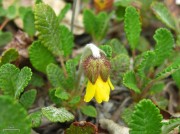
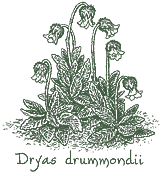
Inhabiting the chilly haunts of the Arctic, northern North America from Alaska to Newfoundland and south to Montana, this stalwart, dwarf perennial is named for the Greek nymph Dryas.
Oblong, evergreen and toothed, the glossy dark green foliage resembles tiny oak leaves with white wooly undersides. Leafy, creeping reddish stems form a loose ground-hugging mat that bronzes at the onset of winter. Nodding yellow bells held by decorative, brown-haired green calyxes ring in summer.
An ideal choice for the rockery or alpine garden, its long, silvery feathered seed heads keep our interest sparked, while a cool and open, well drained locale keeps this charming sun lover content.
Blooms June–July.
Size: 6" – 10" high x 12" wide.
Hardy to zone 3.
Dryopteris
Wood Fern
One of the largest genera of ferns, Dryopteris adore light shade in wooded locales and evenly moist, compost-rich soil. Their attractive feathery fronds lend refined texture to the broader foliage of other plants, such as Hydrangeas, Ligularia and Astilboides.
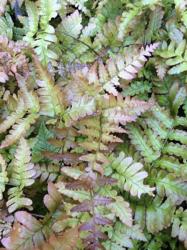
Once you’ve ushered this colorful easy-care fern into your woodland, you’ll see how deceptive its common name is. While ‘Brilliance’ delivers toasty russet shades in autumn, the dynamic display actually commences in spring when young pink fiddleheads transmute vibrant reddish copper and pink hues, and then mellow to a bronzy green. Polished dark green and tropical-looking, mature fronds are embellished during the summer by dramatic bright red spores on their flipsides and contrasting henna-tinted new growth throughout the season.
‘Brilliance’ can be utilized as a tall textural ground cover or as a striking specimen that remains evergreen in milder areas and relishes even moisture and good drainage.
Size: 2' 0" high x 2' 0" wide.
Hardy to zone 5.
Polished, stiff and sumptuously dark green, this noble southern denizen forges an impressive nearly vertical clump of tall, leathery narrow fronds. Undeterred by heat, humidity and alkaline sites, Southern Wood Fern remains evergreen where winters are mild, relishing moist soil but also performing well in drier conditions. D. ludoviciana makes a verdurous no-fuss partner for Polygonatum o. ‘Variegatum’ in a shady border or woodland setting.
Size: 3' 0" – 4' 0" high x 18" – 2' 0" wide.
Hardy to zone 6.
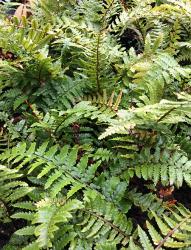
This easily grown, clumping Asian fern unfurls otherworldly black-stemmed croziers followed by lustrous evergreen fronds that stretch to 2 ft., sporting curious black fuzz at their bases. Wildly popular due to its erect princely appearance, D. pycnopteroides can be ensconced near water or in damp shady niches.
Size: 18" high x 2' 0" wide.
Hardy to zone 6.
Echinacea
Coneflower
Notable for a dashing display of bold, daisy-like cut flowers and an easy-to-get-along-with personality, Echinacea is favored by beginning and experienced gardeners for its colorful yet indestructible nature. Sculpted with prominent raised central cones, the hefty flower heads of this summer-blooming perennial are lifted above the greenery on sturdy stems, which are firm enough to hold them without staking. Native to the eastern and central U.S., the dark green, lanceolate leaves are reminiscent of a close relative, Rudbeckia. Perfect in a perennial border or peppered throughout a meadow garden, Coneflower’s erect stalks complement the more relaxed look of other plants.
Echinacea Big Sky™ ‘Sunrise’ (P-1377)
OUT OF PRODUCTION AT THIS TIME
Email me when this plant is available
More composed than our other Big Sky offering, but just as reliable, this cultivar serves up illuminated butter yellow blooms that soothe the colorful chaos of the summertime border. Subtly toothed, tasteful foliage defines a full, leafy footing for the ample-sized blooms, which emit a roselike scent while their raised greenish centers mature with golden highlights. (pp#16235)
Blooms August–September.
Size: 2-1/2' – 3' 0" high x 18" wide.
Hardy to zone 4.
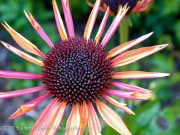
(Evan Saul)
One of the celebrated stars from Richard Saul’s highly touted Big Sky breeding program in Atlanta, Georgia, ‘Sundown’ colors the landscape with blazing intensity. Vibrant, nearly iridescent pinkish orange petals bend back and overlap one another as they swirl around a pronounced chocolate-brown hub. A cross between purpurea and paradoxa, this Echinacea is not only a flamboyant, sweetly fragrant beauty, but a stocky workhorse delivering vigorous, multibranched stems and broad dark green foliage. (PPAF)
Blooms August?September.
Size: 2-1/2' – 3' 0" high x 18" wide.
Hardy to zone 4.
Echinacea ‘Harvest Moon™’ (P-1444)
OUT OF PRODUCTION AT THIS TIME
Email me when this plant is available
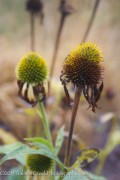
“Echinacea” is derived from the greek word for hedgehog and this Echinacea’s pronounced rusty orange cones remind us of the little critter’s spiky fur. Lax, loosely arranged and luminous, the perfumed, overlapping golden yellow rays span 4 in. across and are resilient, even during the worst summer heat. Another prized Richard Saul introduction, ‘Harvest Moon’s extra long lasting, autumn-hued flowers are bolstered by abundantly branched staunch stems and a good-looking, compact leafy base. (pp#17652)
Blooms late July – September.
Size: 2' 0" high x 18" wide.
Hardy to zone 4.
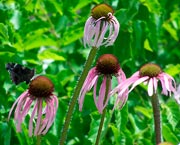
Offering a uniquely different floral presentation, this Echinacea’s large blooms consist of ethereally rayed, pale pink to purple petals delicately draped from a coppery-orange center. Narrow, toothless olive-green leaves clothe strong stems beneath the perfect-for-cutting flowers. Echinacea pallida’s staunch adaptable habit can be naturalized en masse, sprinkled in a cottage garden or added to a butterfly planting.
Blooms June–July
Size: 2' 0" – 3' 0" high x 12" – 18" wide.
Hardy to zone 3.
Each $11.00
Endemic only to the Ozark region of Arkansas and Missouri, this rare easy-going U.S. native is unique, as the species suggests, for the large ebullient yellow flowers it unfurls rather than the commonly colored purple, pink or white ones. Smooth lance-shaped dark green leaves coupled with hearty light green stalks boost the enchanting perfumed display of slender reflexed petals sashaying around hefty copper-brown central cones. Savored by bees, butterflies and songbirds, especially goldfinch, Yellow Coneflower looks outstanding when massed, lends radiant accents to cut arrangements and produces a robust taproot that tolerates poor soil and drought.
Blooms June–August
Size: 2' 0" – 3' 0" high x 10" – 15" wide.
Hardy to zone 5.
Echinacea purpurea ‘Kims Knee High’ (P-2037)
Each $11.75
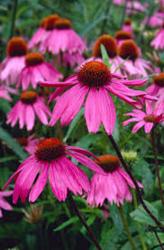
Developed by Niche Garden’s founder, Kim Hawks, this long-blooming pint-sized Echinacea is an entire foot shorter than its native American counterpart. A steadfast foundation of stiff stems clad in dapper coarsely-toothed dark greenery shoulders the prismatic purplish pink daisies, each hosting elegantly pendent petals plus a shimmering copper-orange pincushion center. Unrivaled for the border’s forefront, space-shy gardens or containers, ‘Kim’s Knee High’s reliable mettle never encroaches on her neighbors, delivers flowers all summer long and nourishes goldfinches with tasty seed heads. (pp#12,242)
Blooms July–September
Size: 15" – 2' 0" high x 12" – 2' 0" wide.
Hardy to zone 3.

More than 30 years after Jelitto Seeds introduced ‘Magnus’, the same well-regarded company has now released a new version, which they say is vastly superior to the original cultivar. ‘Magnus Superior’ is rapidly gaining recognition with its deeper lavender-hued horizontal rays, larger radiant orange and penny-colored cones, plus firm dark stems and overall heartier constitution. Though ‘Magnus’ has enjoyed award-winning celebrity status for years and is considered by many to be the best cultivated Echinacea in the trade, this new kid on the block deserves a prime spot either in a border, naturalized area or wildflower garden where he can prove his worth.
Blooms July–September
Size: 3' 0" high x 18" wide.
Hardy to zone 4.
Echinacea purpurea ‘Pica Bella’ (P-1692)
Each $11.75
If you’re looking for a new Echinacea that possesses plenty of fortitude, you’ll definitely want to consider this floriferous beauty. Dressed in dazzling watermelon-pink shades, uniquely slender petals, featuring upturned margins, are widely spaced and extend horizontally from large nearly iridescent orange-bronze cones that goldfinches love to visit. Noteworthy among Echinaceas for its fine textured floral parade, ‘Pica Bella’ stands steady on compact brawny stalks garbed with tapering, toothed green leaves.
Blooms July–September
Size: 2' 0" – 3' 0" high x 18" – 2' 0" wide.
Hardy to zone 4.
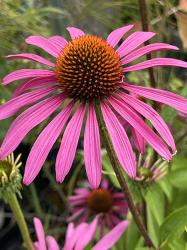
This gorgeous pollinator minion and close Echinacea ‘Magnus’ relation grows slightly shorter and bears large darkly hued carmine-red blooms with petals that extend out from the bronze-colored central cones in a distinctive horizontal fashion. Developed by Germany’s Jelitto Seeds and touted as one of the best in the genus, ‘Ruby Star’s sturdy lanceolate dark greenery can be added to meadows, perennial borders and wildflower gardens amid Rudbeckia ‘Viette’s Little Suzy’, Veronicastrum ‘Challenger’ and Molinia ‘Purple Infusion’. It nourishes Goldfinches and heroically tackles clay, poor soil, heat, humidity and dry conditions.
Blooms July–September
Size: 3' 0" – 3-1/2' high x 18" wide.
Hardy to zone 4.
Echinacea purpurea ‘White Swan’ (P-1021)
Each $11.00
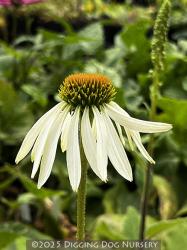
Regal as the name implies, large, pure white flowers crest branching, stalwart stems cloaked in handsome dark green foliage. Broad and slightly reflexed, the bright petals achieve a stunning contrast as they skirt each golden-brown boss. With an upright stance, ‘White Swan’ looks simply elegant in the company of Monarda ‘Grand Marshall’ and a dark red Sanguisorba.
Blooms late July–September
Size: 2-1/2' – 3' 0" high x 18" wide.
Hardy to zone 4.
Colored in rich, deep pink hues, the widely spaced, thin rays of this distinctive long bloomer turn upward and follow the sun throughout the day. While its flowers are a departure from the more typically reflexed Echinacea petals, its narrow, medium green leaf mass is somewhat shorter than other genus members.
Closely related to the endangered species that thrives in the cedar glades of central Tennessee, this exciting selection comes to us from Germany’s Jelitto Seeds. ‘Rocky Top Hybrids’ is well-suited for the border or a more untamed setting amidst a stand of Deschampsia and Panicum.
Blooms July–September.
Size: 2' 0" high x 18" wide.
Hardy to zone 5.
Echinops
Globe Thistle
Bees and butterflies adore Echinops. They are so undemanding that you will too. Equally fabulous in the garden or in a vase as a fresh or dried cut flower, their impressive profile brings intriguing definition to surrounding softer forms. Thriving in well-drained soil, even if it’s poor or sandy, the Globe Thistle is a sensational perennial worth making room for.

Surreal-looking, intensely blue globes are perched atop sturdy stalks lined with winsome, jagged-edged gray-green foliage. The perfectly round blooms and statuesque bearing can be backlit by the late afternoon sun and planted en masse amid spiky Muhlenbergia rigens and the dark domes of Angelica gigas.
Blooms July–September
Size: 4' 0" high x 18" wide.
Hardy to zone 4.
Echinops bannaticus ‘Star Frost’ (P-1592)
Each $11.75

Round, pearly-white blooms sojourn on well-branched steadfast stalks that aren’t quite as tall as Echinops ‘Blue Glow’s. Thistle-like narrow green leaves flash downy gray-green flip sides, while the distinctive flowers proudly illuminate a drift of Schizachyrium ‘MinnblueA’.
Blooms July–early September
Size: 3-1/3' high x 18" wide.
Hardy to zone 4.
Echinops bannaticus ‘Taplow Blue’ (P-1931)
Each $13.00
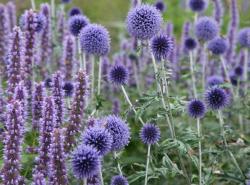
Listed in Jeff Cox’s Perennial All-Stars as one of 150 top perennial performers, ‘Taplow Blue’ attracts gardeners, bees and butterflies alike. Branched, leafy pewter-hued stems gracefully curve upwards, attired in handsome, deeply cut thistle-like grey-green leaves with niveous backsides. Surmounting strong stems for several months, the powdery steel-blue spherical heads make an extraordinary presentation, especially when massed or positioned alongside softer looking flowers such as Solidago ‘Fireworks’ and Aster ‘Bridal Veil’.
Blooms July–September
Size: 4' 0" – 5' 0" high x 20" – 2' 0" wide.
Hardy to zone 4.
Entrancing gardeners, florists and honey bees, ‘Platinum Blue’ presents an architectural spectacle of imposing steel-blue blossoms bolstered by fuzzy, branching, stiff white stems. The cut-flower-perfect spheres are packed with petite starry blooms above deeply-divided grayish green foliage with marble-hued flip sides. This handsome perennial can lodge in a border amid Phlox ‘David’s Lavender’ and Monarda ‘Purple Rooster’, where its nervy bent tolerates poor soil, coastal conditions and periodic dry spells.
Blooms July–early September
Size: 2-1/2' – 3' 0" high x 15" – 18" wide.
Hardy to zone 4.

Brimming with innate artistry, this durable perennial unleashes a pollinator’s mecca of stunning, golf ball-sized dark blue blooms. Stiff silver-laced stems soldier straight up, producing deeply chiseled, spine-tipped green leaves, whose flip sides sport a mercury-hued tomentose. Ideal for juxtaposing against Sorghastrum ‘Indian Steel’, Phlox ‘Jeana’ and Verbascum ‘Wedding Candles’, clump-forming ‘Veitch’s Blue’ grows slightly smaller than the species, while its flowers are more profuse and a deeper blue.
Blooms July–September
Size: 3' 0" – 3-1/2' high x 18" – 2' 0" wide.
Hardy to zone 4.
Echinops sphaerocephalus ‘Arctic Glow’ (P-0845)
Each $11.75
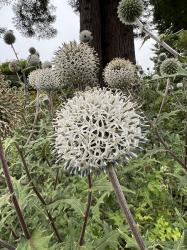
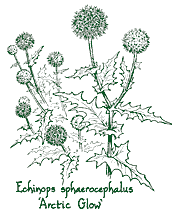
Topping erect mahogany-hued stems, snow-white balls provide a stately element heightened by prickly frost-imbued greenery. Planted with compelling companions like Aconitum, Digitalis ‘Gigantea Gelber Herold’ and Veronicastrum, its noble orbs appear to glow.
Blooms July–September
Size: 2-1/2' – 3' 0" high x 18" wide.
Hardy to zone 4.
Each $10.75
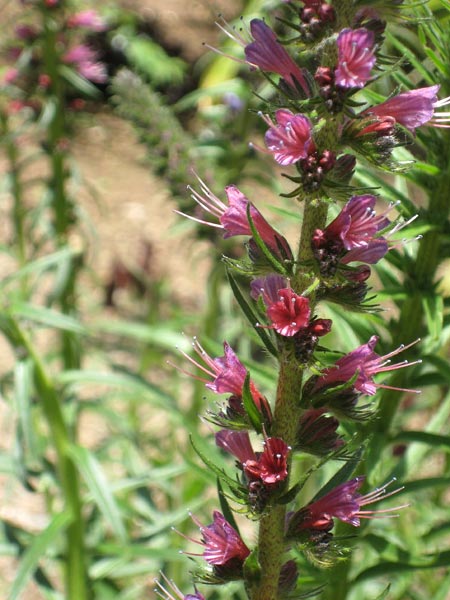
The rich sanguine hue of Echium’s bold columns is tempered slightly by a dusting of tiny whitish hairs and below their abundant display, lance-shaped leaves decorate the flowering stems. By nature a biennial, when planted in well drained soils this eastern European native is proving reliably perennial. Show it off amidst other meadow plants such as Deschampsia, Stipa gigantea and Salvia ‘Swan Lake’.
Blooms July–August.
Size: 2-1/2' – 3' 0" high x 15" – 18" wide.
Hardy to zone 7.
Grassy Bells is a sophisticated choice for atop a wall, a crevice, or any other tight spot. The tidy tufts of lustrous grassy foliage offer a refined cushion from which prostrate stems bear upward-facing, violet-blue bells gathered in abundant, ball-like clusters. Kin to the Campanulas and found on limestone slopes from the Mediterranean to eastern Europe, this superb perennial demands well drained, even gritty, soil.
Blooms June–July.
Size: 4" – 6" high x 12" – 18" wide.
Hardy to zone 4.
Eomecon
Poppy of the Dawn
Each $12.75
A rare relative of our native bloodroot, only one species of this Chinese native exists. Spreading by underground rhizomes, long reddish petioles host glaucous, nearly succulent leaves that look like large wavy-edged hearts marked by light veining. Four-petaled, nearly transparent white flowers arranged in airy terminal panicles are anchored by prominent yellow stamens. At home in very shady places, let this exotic perennial colonize the ground beneath Kerria japonica ‘Albiflora’.
Blooms April.
Size: 18" high x 18" & spreading wide.
Hardy to zone 6.
Epilobium
California Fuchsia
Debuting pretty tubular blooms that are light pink and infused with salmon, this unique, shrubby selection is a welcome departure from the more common orange-hued Epilobiums. A hummingbird haven, the slender, late-blooming flared flowers festoon an attractive, somewhat woody mound of soft-looking sage-green leaves. Tailor-made for natural-style plantings or atop garden walls, ‘Marin Pink’s robust habit needs good drainage, occasional summer watering and a late winter pruning. Its slow spreading rhizomes acquiesce to drought as well as poor rocky enclaves.
Blooms August–mid October
Size: 2' 0" high x 3' 0" wide.
Hardy to zone 7.
Set aglow by a brilliant plethora of large trumpet-shaped scarlet blooms, narrow velvet-soft silver leaves densely attire the low fine textured mound. A dazzling hummingbird minion, this native Californian sun-lover appreciates well-drained soil and infrequent pinchings to maintain its tailored slow spreading habit that remains evergreen in milder locales. ‘Chaparral Silver’ cheerfully conquers hot weather plus dry difficult conditions, such as south facing slopes, walls and embankments.
Blooms August–November
Size: 12" – 18" high x 3' 0" wide.
Hardy to zone 7.
This coveted ground-hugging subshrub celebrates prismatic, long-lasting late season blooms. Mesmerizing to bees, hummingbirds and plant enthusiasts, droves of dazzling, fluted scarlet flowers festoon fuzzy, deer-resistant pewter-green leaves. One of the lowest growing California Fuchsias, sun-loving ‘Everett’s Choice’ is well-suited for planting on slopes as well as spilling over rock walls or container rims. Acquiescent to dry conditions, it performs best with occasional deep summer waterings plus light afternoon shade in hot locales, while a trim ensures a neat compact profile.
Blooms July–October
Size: 6" – 10" high x 12" – 2' 0" wide.
Zone 7b.
Epimedium
Barrenwort or Bishop’s Hat
Dense and leafy Epimedium is one of our most successful ground covers for the moist woodland setting. New heart-shaped leaves on wiry stems unfurl in spring with a rosy, marbled coloration that fades to green as summer approaches. In autumn, the marbling returns in coral and copper, enduring mild winters. The unusual small flowers (Bishop’s Hats) are held above the foliage in airy sprays, and resemble miniature Columbines. Reliable and long-lived, Epimediums can adapt to drier conditions once established, spreading slowly and steadily. Both flowers and foliage are prized for small arrangements.
Epimedium ‘Amber Queen’ (P-1517)
Each $15.75
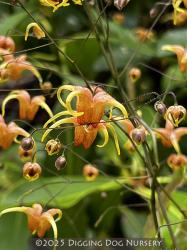
Bred by Blackthorn Nursery owner Robin White, this relatively new Epimedium flavum and Epimedium wushanense cross is adorned with droves of large warm-hued blooms. Arranged in an open fashion on long, nearly invisible black stems, the whimsical deep yellow flowers feature hooked light blonde spurs, red-tinged sepal backs and speckled petals, all melding together for an overall amber shade. Toothed and elongated, tidy heart-shaped foliage heralds spring with a bold russet mottling.
Blooms late March–May
Size: 10" high x 18" wide.
Hardy to zone 5.
We have American Epimedium expert, Darrell Probst, to thank for this wildly popular floriferous hybrid. Beneath the practically peerless bicolored floral display, long, pointed, spiny-edged leaves with hazel-hued bridling compose a stylish dense mound. The 2 ft. tall, arching maroon panicles gather a splendid legion of large white-spurred blooms, embellished by rosy wine-tinted tips. Though ‘Domino’ is uninteresting to deer and bunnies, it promises to entice many 2-legged garden visitors.
Blooms April–May
Size: 18" – 2' 0" high x 2' 0" – 3' 0" wide.
Hardy to zone 5.
‘Enchantress’ is the prized outcome of legendary plantswoman Elizabeth Strangman’s cross between Epimedium dolichostemon and Epimedium leptorrhizum. Buoyant tiny lavender-colored buds and medium-sized silvery lilac flowers with purple inner segments loll above large elongated heart-shaped green leaves. Heightened by undulating margins plus red, henna and crimson brindling in the winter and early spring, this distinctive low growing evergreen can be enjoyed along a pathway or near your favorite bench.
Blooms March–April
Size: 6" – 12" high x 12" – 15" wide.
Hardy to zone 5.
A chance seedling discovered by the late Harold Epstein in his esteemed New York garden, ‘Dark Beauty’s new spring growth entertains a commanding medley of cocoa, wine and damson hues beneath large, white-spurred deep rosy-pink flowers on wire-thin stems. ‘Dark Beauty’s somewhat diminutive clump becomes more green with age, yet the young unfurling heart-style leaves still present lavish dark tones. Graced with a posh presence, this long-lived Epimedium can be ensconced near fellow shade-lovers such as Geranium p. ‘Lily Lovell’ or Rodgersia ‘Chocolate Wings’.
Blooms April–May
Size: 10" – 12" high x 12" – 15" wide.
Hardy to zone 5.
Fresh spring green foliage that’s flushed with cozy chestnut hues premiers large pastel flowers on pale apple green stems. Described by darker flip sides, pinkish lavender sepals plus spidery white-tipped and spurred lilac petals, a fine flood of fairytale-like blooms nearly conceals the handsome medium-sized habit of this easily maintained seldom offered Japanese gem.
Blooms late March–May
Size: 8" – 10" high x 12" wide.
Hardy to zone 4.
Epimedium grandiflorum ‘Lilafee’ (P-0793)
Each $15.75
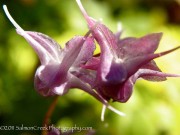
‘Lilafee’ is a delicate delight as a ground cover. Its loose, tall sprays of elegant, long-spurred, lavender violet blossoms rise from a bed of vigorous oval-shaped foliage, purply bronze when new, and bright green as it matures. A carpet of ‘Lilafee’ under a Cercidiphyllum will echo its coloration.
Blooms late March–May.
Size: 6" – 8" high x 12" wide.
Hardy to zone 5.
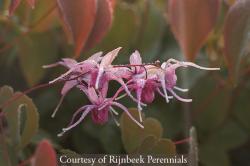
Though this robust large-flowering cultivar was introduced by Cobblewood in 1999, it originated at Pierre Bennerup’s Sunny Border Nurseries. Trimmed with prominent white-tipped spurs, an enchanting bounty of sumptuous wine-purple blooms on wire-thin stems sojourns well above the oval-shaped bright green leaflets, which sport cordate bases, spiny-toothed margins and bronzy-maroon new spring growth. The dapper, dense deciduous clump endures occasional dry conditions, works best en masse and can be planted beneath trees or shrubs, along shady pathways and in woodland gardens.
Blooms April–May
Size: 9" – 12" high x 12" – 15" wide.
Hardy to zone 5.
With a name that’s apropos, this Richard Lighty introduction conjures fanciful flowers distinguished by vivid purple sepals and extended white spurs. Ornately detailed blooms dance on thin dark stems above a marvelous bed of damson-flushed springtime foliage. Generating a compact, yet plucky ground cover, the heart-like leaves develop olive-green hues and maroon margins as they mature. ‘Purple Pixie’ will impart enchanting accents to the dappled recesses of your garden, especially when nestled beside Geranium ‘Claudine Dupont’. (pp#13,966)
Blooms April–May
Size: 9" – 12" high x 12" – 15" wide.
Hardy to zone 5.
Housed within wispy sprays of wire-like reddish stems, cranberry-colored buds unveil myriad large pure white flowers defined by slender spurs that gracefully flare out. The attractive medium-sized green leaves are arrow-shaped, spiny toothed and mulled with burgundy brindling in the spring. An undemanding AGM recipient,‘White Queen’s close-set herbaceous habit can be easily tucked amid tree roots and other shady alcoves, while her exquisite pearly-hued flowers sparkle up neighbors such as Dicentra ‘Bacchanal’ and Geranium ‘Coombland White’.
Blooms late March–May
Size: 12" – 14" high x 12" – 15" wide.
Hardy to zone 5.
Recently introduced from China, this average-sized nearly evergreen Epimedium is a study in color-rich refinement. Copper-infused new growth and elongated, deep green serrated leaves present long racemes of dangling, broad-petaled crisp white flowers with warm yellow-orange inner sepals and stamens. Unfazed by deer and occasional dry periods, ‘Mandarin Star’ shines brightly amid fellow shade aficionados such as Dryopteris ‘Brilliance’ and Geranium p. ‘Lavender Pinwheel’.
Blooms April–May
Size: 16" high x 16" – 18" wide.
Hardy to zone 5.
Epimedium x perralchicum ‘Frohnleiten’ (P-1447)
Each $15.75

With a dainty style that defies its stoic nature, ‘Frohnleiten’ can handle dry conditions and is quick to colonize. Buoyant, loosely formed clusters of pendulous, winged vibrant yellow flowers perch above the tailored leafy clump. Bright green veins dramatically tattoo auburn-tinged spring foliage, while summer brings valiant greenery, and autumn a florid fanfare that occasionally persists into winter.
Blooms April–May
Size: 15" high x 12" – 15" wide.
Hardy to zone 4.
Each $15.75

Originating from a Epimedium leptorrhizum and Epimedium pubescens cross, this delightful Robin White hybrid makes a vigorously spreading clump. Dappled with green and auburn shades, the evergreen leaves loll beneath a fairy’s fest of pink flowers marked by purple tinges and bronze-colored cups on thin stiff stems. (pp#17228)
Blooms late March – May.
Size: 12" high x 18" wide.
Hardy to zone 5.
Exceptional vitality coupled with a generous showing of large, reblooming rosy-pink flowers earn this Darrell Probst introduction the reputation of being the choicest Epimedium available. Bubbling amid lithe, ultrathin stems that rise well above ‘Pink Champagne’s lusty evergreen clump, the playful blooms showcase raspberry-hued cups plus long blush-toned spurs with pale yellow tips. Bold burgundy and violet-tinged calico patterns imprint each lanky, arrow-shaped evergreen leaf and beckon us to take a closer look.
Blooms April–May
Size: 15" – 18" high x 2' 0" – 3' 0" wide.
Hardy to zone 5.
Epimedium pinnatum ssp. colchicum (P-1834)
Each $15.75
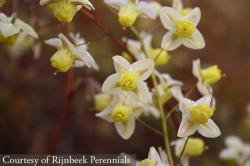
Dwelling throughout the mountainous regions near Georgia’s Black Sea coast, this prized Epimedium begets good-sized jewel-box-like blooms with bright yellow petal-like inner sepals, red spurs and tiny brownish petals. Effulgent outfacing flowers prance above tall, lean leafless stems plus a dashing polished mound of reddish brown-dappled younger leaves offset by cordate dark green mature ones. Considered one of the best ground covers for shady areas, the dense, slow-spreading evergreen clump ensures sprightly floral accents, outstanding vigor and drought tolerance once established.
Blooms April–May
Size: 9" – 15" high x 12" – 18" wide.
Hardy to zone 4.
Each $15.75
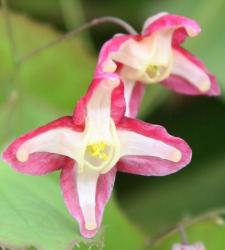
An early spring profusion of origami-like short-spurred crimson and white flowers nearly obscures the wiry stems and pointed spiny-toothed green leaflets. This Epimedium alpina and Epimedium grandiflorum cross is best served by planting in shade, fancying either a woodland setting or the rockery.
Blooms February–March
Size: 9" high x 12" wide.
Hardy to zone 5.
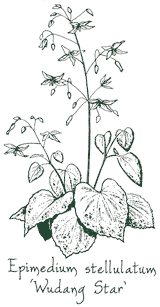
Aptly named ‘Wudang Star’ unfurls a floral delicacy of exquisite pure white blossoms that resemble 4-pointed stars in loosely arranged sprays. Highlighted by prominent yellow stamens, the abundant larger than average blooms are elevated on tall lean stems above a lustrous spiny green foundation, distinctive for its arrowhead- shaped leaves and newly emerging growth with bronzy pink margins. Let this rare Chinese gem brighten your garden’s shady nooks and you’ll see why acclaimed plantsman Roy Lancaster introduced it.
Blooms March–April.
Size: 18" high x 15" – 18" wide.
Hardy to zone 4.
We have botanist Andre Donkelaar, who worked at Ghent University’s Botanic Garden over 150 years ago, to thank for this marvelous steadfast cultivar. An Epimedium pinnatum ssp. colchicum and Epimedium grandiflorum descendant, ‘Cupreum’ has been volunteering a pastel floral delicacy of petite rosy-coral blooms with lemon-yellow central cups ever since its 1854 introduction. Prancing atop ultrathin stems and hair-fringed bronzy-red spring foliage, the sprightly flowers enliven an attractive and enduring evergreen clump that becomes more green in the summer, and then broadcasts cozy maroon and chestnut hues for fall.
Blooms April–May
Size: 12" – 15" high x 15" – 18" wide.
Hardy to zone 5.
Epimedium x versicolor ‘Sulphureum’ (P-0063)
Each $15.75
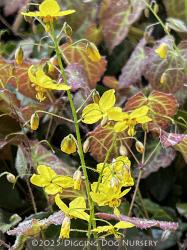
Though this Epimedium grandiflorum and Epimedium pinnatum ssp. colchicum hybrid was selected well over 150 years ago, it still upholds an impeccable long-standing reputation as the go-to Epimedium for difficult shady garden recesses. The suave, closely hewn ground covering clump is described by trim bright red flower stalks plus sprightly pale yellow ornate blossoms above leathery heart-shaped green leaves, donning artful wine-hued etchings in spring and autumn maroon blotching. Fast growing, energetic and swarthy, ‘Sulphureum’ mingles well with early blooming Pulmonarias or Brunneras, while conquering a wide range of soil.
Blooms March–April
Size: 12" – 16" high x 12" – 18" wide.
Hardy to zone 5.
We bet you’ll take your hats off to this ‘Bishop’s Hat’. Its intriguing flowers have petals of yellow, sepals of coppery orange, anthers of green, and spurs adorned with red streaks. The light green spring foliage is spiny-toothed and has a reddish margin. We plant it alongside our shaded steps and benches amid Helleborus ‘Ivory Prince’, so that we can enjoy the detail and contrasting colors.
Blooms April–May.
Size: 12" high x 12" wide.
Hardy to zone 5.
Lauded as one of the most colorful warleyense species, this toasty hued hybrid between Epimedium alpinum and Epimedium pinnatum ssp. colchicum occurred in the Warley Place garden of Britain’s infamous curmudgeon plantswoman, Miss Willmott. A central yellow cup and subtle salmon overtones enrich the burnt reddish orange flowers, which are poised on 15 in. narrow stems. Below the wondrous blooms, a fast-growing mostly-evergreen foundation of ample-sized foliage hosts young plum-imbued leaves maturing to green, then ending the season brindled with bronze and burgundy tones.
Blooms April–May
Size: 15" high x 2' 0" – 2-1/2' wide.
Hardy to zone 5.
Epimedium x warleyense ‘Orange Queen’ (P-1785)
Each $15.75
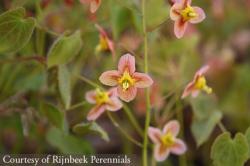
We bet you’ll take your hats off to this fabulous ‘Bishop’s Hat’. An Ernest Pagels cross between Epimedium alpinum and Epimedium pinnatum ssp. colchicum, ‘Orange Queen’s intriguing flowers showcase soft coppery-tangerine-colored petals, greenish anthers and spurs painted with red streaks. The light green foliage is spiny toothed and warmed by reddish margins. We place it alongside our shaded steps and benches amid Helleborus ‘Ivory Prince’, so that we can enjoy the detail and contrasting colors.
Blooms March–April
Size: 16" high x 16" – 18" wide.
Hardy to zone 5.
Epimedium x youngianum ‘Merlin’ (P-1987)
Each $15.75
Springing forth as a chance seedling in esteemed plantswoman Amy Doncaster’s British garden, this small growing Epimedium conjures pointed wine-colored buds and lovely 2-toned blooms. Plump spurless flowers, distinguished by dusky mauve-purple petals with white bases, populate dense sprays atop thread-like stems. A tailored clump of pointed close-set foliage plus violet and cocoa-tinted young spring growth anchors the unusual nodding blossoms. Lodge ‘Merlin’ in the shadows and a magical spectacle is yours for the viewing.
Blooms April–May
Size: 10" – 12" high x 12" wide.
Hardy to zone 5.
Epimedium x youngianum ‘Niveum’ (P-0571)
Each $15.75
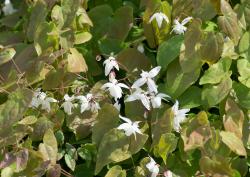
Illuminated by a breezy, overhead display of star-like, pure white flowers, the emerging henna-hued leaves grow into a compact mass that stays neat all season. Smaller sized, handsome pointed green leaflets have toothed margins and end the season with a lambent fall finale, imparting scarlet and crimson colors.
Blooms April–May
Size: 8" – 10" high x 12" wide.
Hardy to zone 5.
Epimedium x youngianum ‘Roseum’ (P-1448)
Each $15.75
Documented in a 1863 Parisian herbarium, this ladylike Epimedium premiers fleurs d’un rose clair. Sprays of soft lilac-pink, narcissus-like flowers dangle from stiff, needle-thin reddish stems. Fashioning an attractive bushy mound, the pointed ovate leaflets first emerge with warm auburn hues and green-up as spring progresses.
Blooms April – May.
Size: 8" high x 15" wide.
Hardy to zone 5.
Erigeron
Fleabane
With a carefree guise that barely hints at their stalwart nature, Erigeron promises to embellish any little spot: cracks and crevices, window boxes, between paving stones or a border’s foreground. Content in well-draining sites, even those with sandy soil, these vigorous, no-nonsense perennials parade daisy-like blooms for months on end and can easily withstand periodic dry spells.

Beloved by bees and butterflies, ebullient narrow-rayed daises with sunny yellow eyes prance above a bright gray-green mound of filigree-like foliage. Tightly packed petals, ranging in colors from soft pink to lavender blue, distinguish the petite blooms. A no nonsense diminutive North American native that belies its delicate-looking demeanor, this darling Fleabane is well-suited for alpine gardens, edging a pathway or adorning containers. It can endure poor dry abodes, demands sharp draining soil, doesn’t interest the deer and is most effective when planted en masse.
Blooms May—June.
Size: 4" high x 8" wide.
Hardy to zone 4.
Erigeron glaucus ‘Albus’ (P-2140)
Each $10.75
Grounded by thick, rounded grayish green leaves, a legion of large daisy-style white blooms with sunny-yellow centers romps upon stocky upright stems all summer long. ‘Albus’s trim, cushioned mound lends a jaunty evergreen aspect to steps, pathways, mass plantings and rock gardens.
Blooms May–October
Size: 6" – 12" high x 12" – 18" wide.
Hardy to zone 7.
Bart O’Brien at California’s Rancho Santa Ana Botanic Garden selected this exceptional California native for its extra large 3 in. wide lavender daisies and trim compact evergreen mound. Enticing finches, butterflies and other plant lovers, dozens of sprightly greenish golden-eyed flowers unfurl from spring through summer above low growing leaves that can handle coastal front lines. Enriched soil, occasional deadheading, partial shade if planted inland plus a yearly cut back ensure ‘Bountiful’s abundant good looks.
Blooms May–October
Size: 6" – 12" high x 12" – 18" wide.
Hardy to zone 7.
Erigeron glaucus ‘Cape Sebastian’ (P-0719)
Each $10.75
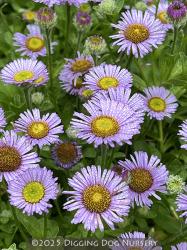
Lauded as the smallest and most compact of the glaucus selections, this valiant California native hosts a jaunty pollinator hub of copious saffron-centered lavender-hued daisies. Short stout stems lift the long-blooming flowers above a tailored evergreen clump with durable spoon-shaped green leaves. Unfazed by drought, coastal wind, salt spray plus sandy and clay soil, ‘Cape Sebastian’ thrives in sunny or lightly shaded niches, gracing small-sized gardens, mixed borders, rockeries and seaside plantings.
Blooms May–October
Size: 8" – 2' 0" high x 18" – 2' 0" wide.
Hardy to zone 7.
Erigeron glaucus ‘Ron’s Pink’ (P-1258)
Each $10.75

Here’s a perennial we’ve been waiting for: a pink flowering, compact selection of our native seaside daisy. Its upbeat, 2 in. wide daisies feature crowded delicate rays centered with large yellow eyes. This Ron Lutsko discovery hosts droves of blooms above a lush and tidy, bluish green basal rosette. Chipper yet tough, evergreen ‘Ron’s Pink’ maintains its composure through salt spray, howling winds and coastal drought.
Blooms May–November.
Size: 6" – 12" high x 12" wide.
Zone 8/9.

For its large and deeply colored daisies, its bounteous bloom and neat compact character, British nursery owner, Fred Yates, selected this outstanding, easy-to-grow Erigeron from a group of Erigeron glaucus seedlings. A low, dense evergreen mound of handsome, balsam-scented gray-green foliage gets buried under the nearly 2 in. wide lavender-pink flowers that are elevated on short steadfast stems and brightened by chartreuse and gold eyes.
An adorable yet resilient addition to a cottage garden, rockery, hillside or border’s front row, ‘Sea Breeze’ handles coastal living and some drought, but requires well draining soil and light shade where its hot. (pp#12,076)
Blooms May – October.
Size: 6" – 12" high x 12" – 18" wide.
Hardy to zone 7.
Erigeron glaucus ‘Wayne Roderick’ (P-0064)
Each $10.75
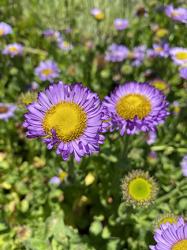
Selected by esteemed California horticulturalist Wayne Roderick, this swarthy, snug version of our native seaside daisy produces a summer-long cascade of endearing 1 ½ in. wide lavender-blue daisies perched on short stems above a dense evergreen carpet of neat bluish green foliage. Unfazed by deer, drought and coastal conditions, ‘Wayne Roderick’ beguiles bees and butterflies with its gold-eyed posies that are darker hued than most other glaucus species.
Blooms May–October
Size: 6" – 12" high x 18" wide.
Hardy to zone 7.

Boasting a prestigious AGM, this happy-go-lucky ground-covering perennial yields a slew of adorable, two-toned fine-petaled blooms that range from white to rose-pink and lilac. The floriferous summer-long gala garnishes a winsome, low bushy mound defined by tiny, narrow grayish green lanceolate leaves. Tailor-made for pathway edges, hanging baskets, steps and pavers, ‘Stallone’s lineage hails from Mexico to Panama, so naturally its undemanding mettle craves a warm, dry, well-drained abode.
Blooms May–October
Size: 12" – 15" high x 15" – 20" wide.
Hardy to zone 6.
Erigeron x moerheimii (P-0066)
Each $10.50
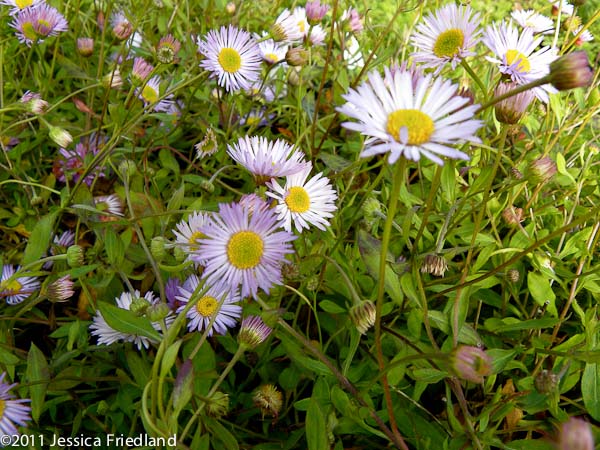
This low growing Erigeron is a marathon bloomer with a tenacious mettle and charm to spare. Thin-rayed, 1 in. wide soft pink daisies produce a bountiful, nearly year round display that almost veils the sprightly bundle of slender wiry stems and small narrow green leaves.
Rumored to be from the Royal Moerheim, a Dutch Nursery founded in 1888 and distinguished for its ‘Natural Style’ plants, Erigeron x moerheimii resembles Erigeron karvinskianus, but is more compact and doesn’t reseed. It can be enjoyed spilling over a wall or softening steps and pathways.
Blooms April – October.
Size: 12" – 2' 0" high x 2' 0" – 3' 0" wide.
Hardy to zone 8.
Erigeron pulchellus var. pulchellus ‘Lynnhaven Carpet’ (P-2089)
Each $11.00
PREORDER FOR SPRING 2026

A slow-spreading stoloniferous evergreen, this fetching selection of our American native was discovered on Clarice Keeling’s Virginia Beach property near the banks of the Lynnhaven River. Butterfly-friendly, fringed, fine-rayed and abundant—the perky, yellow-centered, daisy-style white flowers impart a soft lavender blush atop sturdy foot-tall stems. Large paddle-shaped gray-green leaves with serrated margins and a fuzzy finish describe the tidy, thick, ground-hugging mat that possesses enough brawn to easily tackle heat, humidity, dry shade and lean soil, yet detests too much fertility.
Blooms May–June
Size: 6" – 12" high x 12" – 18" wide.
Hardy to zone 5.
Erigeron speciosus ‘Azure Fairy’ (P-1934)
Each $10.50
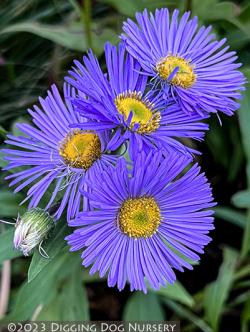
An ebullient bevy of semidouble, narrow-rayed lavender-hued daisies with sun-kissed centers floats all summer long on strong stems. Yielding a reliable bushy green clump and fantastic good-sized cut flowers to boot, ‘Azure Fairy’s pixie-like charm belies its adaptable peppy habit, which looks best en masse and abides clay or sandy soil.
Blooms June–August
Size: 2' 0" high x 2' 0" wide.
Hardy to zone 3.
Erigeron speciosus ‘Pink Jewel’ (P-1257)
Each $10.50
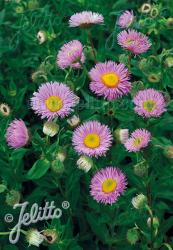
In an ebullient display, ‘Pink Jewel’s thin, closely set orchid-pink petals abundantly converge around golden yellow centers. From a bed of round-tipped basal foliage, the sturdy, branching stems clad in smaller, lance-shaped leaves bolster 1 ½ in. wide, Aster-like blooms which are perfect for cutting. Extremely hardy and undemanding, this floriferous, western U.S. native can be partnered with yellow-flowering Achillea ‘Marmalade’ for a collage of cheerful flowers.
Blooms June–August
Size: 18" – 2' 0" high x 2' 0" wide.
Zone 3/4.
Eriogonum
Buckwheat
Referring to a woolly plant with bent stems, this diverse North American genus aptly procures its name from the Greek word erion, which translates “wool,” and gonu meaning “knee or joint.” Our noteworthy Wild Buckwheat selections offer attractive foliage and intrepid personas coupled with a flood of blooms for pollinators and gardeners alike.
Eriogonum allenii ‘Little Rascal’ (P-1836)
Each $12.00
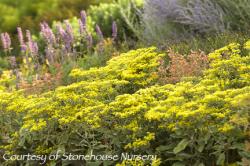
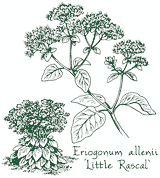
Though its lighthearted cultivar name and rather serious sounding common moniker may conjure divergent images, this reliable underused perennial has virtues everyone agrees on: long bloom period, ease of maintenance, cold hardiness and superb drought tolerance. Gray-green paddle-like leaves compose a tidy, dense low growing rosette beneath the bounty of beautiful bright golden umbels. Adored by bees, butterflies and hummingbirds, the parasol-shaped blooms mature with bronzy-orange hues and later develop intriguing seed heads. Sunshine, good air circulation and dry, fast-draining lean soil will keep ‘Little Rascal’ from making too much mischief!
Blooms June–September
Size: 16" high x 16" wide.
Hardy to zone 5.
Eriogonum grande var. rubescens (P-2091)
OUT OF PRODUCTION AT THIS TIME
Email me when this plant is available
Reputed to be the showiest small Buckwheat available, this rare, low mounding perennial subshrub exhibits an easy-care drought-tolerant bent, which provides significant food for bees, butterflies and beneficial insects, as well as birds and small mammals. Pouffed rounded clusters of long-blooming, vibrant rose-pink flowers perch on tall stout stalks, while petite, long-petioled wavy gray-green leaves with white woolen undersides shape a compact evergreen tussock. Populating California’s Channel Islands, Red Buckwheat prefers alkaline soil, withstands clay plus coastal conditions, and can be massed on dry hillsides or planted amid rockwork and atop walls.
Blooms June–October
Size: 12" high x 2' 0" – 3' 0" wide.
Zone 8b.
Hailing from western Colorado, this long-lived Plants Select introduction celebrates a colorful tough-as-nails constitution that triumphs over cold, heat, drought and deer. Low slow-spreading mats of small leathery green leaves premier copious tiny bright yellow blossoms on 12 to 15 in. stalks. Favored by beneficial insects, bee, birds and butterflies, the striking cut-flower-perfect blooms deepen to orange and eventually turn rust by autumn, while the attractive evergreen foliage develops red and purple hues. Well-suited for troughs, edging, alpine gardens and broad sweeps, ‘Psdowns’ relishes either a lean sandy soil or an average garden loam, an early spring trim plus plenty of sun.
Blooms May–July
Size: 12" – 16" high x 18" – 2' 0" wide.
Hardy to zone 3.
Erodium
Heron’s Bill

Sharing the same resilience and long summer blooming period as many of its Geranium cousins, this dainty low growing perennial hails from the Pyrenees. A pleasing dome-shaped clump entertains notched, finely divided hairy leaves and showy clusters of five-petaled magenta-hued flowers on numerous straight ultra-thin stems. Marked by darker blotches and rich rosy lilac shades, the saucer-styled blooms give way to prominent slender beak-like fruit, which eventually twists into two tight spirals, inspiring the genus name.
A marvelous light-on-its-feet contender for the rockery or a border’s foreground, Herons Bill detests too much water and easily flourishes in a sunny well-drained spot.
Blooms June–September.
Size: 18" high x 18" wide.
Hardy to zone 6.
Eryngium

Sea Holly
From its leathery lobed leaves to the spiny decorative bracts that host the flower, the dynamic Sea Holly has a sense of movement that is up and out. Excellent in fresh or dried arrangements, the flowers are borne on tall branching stems, and the terminal blooms hold their color while lateral flowers develop, until the entire stem is covered with mature blossoms. Eryngiums love sharp-draining soil in the open sun, and are an arresting addition to the mixed border, especially when planted amidst Rudbeckia, Achillea and grasses.
Hailing from Argentina, this statuesque Agave look-alike wields a lustrous apple-green rosette with thick, sharp-toothed sword-like leaves. The impressive boldly-textured foundation shoulders steadfast upright flower stalks featuring a bee and butterfly-friendly candelabra of dense greenish white thimbles, which age to a warm cocoa color and make striking additions to cut arrangements. An easy-care semievergreen toughie for mixed borders, massed plantings or sentinel positions, Eryngium agavifolium can lodge amongst other sun-lovers such as Festuca mairei and Verbascum ‘Gainsborough’ where it relishes good drainage and handles drought once established.
Blooms July–September
Size: 4' 0" high x 2' 0" wide.
Hardy to zone 6.
Evoking images of ornate Elizabethan ruffs and flaunting an unsurpassed beauty, this stalwart subalpine European native has been continually cultivated since the 1500s. Wildly popular among bees, butterflies and florists, the dense cone-shaped gunmetal-blue flower heads reside on feathery, soft-to-the-touch collars, each composed of 12 to 18 finely divided, upward curving silver-blue bracts. Stout cerulean-hued stalks with upper, 3-lobed bluish-green leaves elevate the sensational display, while an attractive, green basal rosette of toothed, heart-shaped foliage is sustained by a large taproot that detests being disturbed.
Blooms July–September
Size: 18" – 2-1/2' high x 18" – 2-1/2' wide.
Hardy to zone 5.
This cold-hardy species yields up-curving bracts that are long spiny slivers of silver plus thistle-like metallic-blue blossoms, surmounting branched stems that are tinted blue on their upper extremities. Marked with a smattering of mercury-hued speckles and white veining, deeply cut, gray-green leaves make a low-lying rosette for the unique floral phenomenon.
Blooms July–September
Size: 2' 0" high x 18" wide.
Hardy to zone 4.
Each $15.00
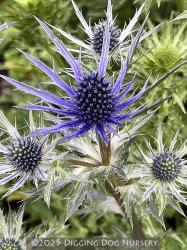
This hardy Eryngium is all about blue—the electrifying, iridescent kind that promises to tantalize any garden visitor. A Blooms of Bressingham introduction, ‘Big Blue’s spine-edged green foliage and thick stems create an intriguing candelabra-shaped base for the bright 4 in. wide inflorescences. A blue drama is yours for the viewing as frosty-white bracts and green cones, over the course of several weeks, gradually transmute stunning cerulean shades, imbuing even the stalks below. (PPAF)
Blooms July–September
Size: 2' 0" – 2-1/2' high x 15" – 18" wide.
Zone 4/5.
Each $12.50

Hailing from the Pyrenees, this easily grown perennial boasts a compact clump of crisp undulating gray-green foliage and decorative thistle-like blooms. The distinctive ground-level leaves are artfully chiseled into narrow segments and etched with striking broad white veins. Mustering durable cool-colored intrigue, the round, medium-sized blue-green flowers are tended by long, linear iron-gray bracts.
Blooms July–August
Size: 12" high x 12" wide.
Hardy to zone 5.
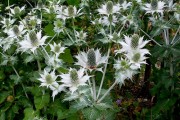
Back in Victorian times, Miss Willmott was so enamored with this Eryngium that she secretly scattered its seed in other people’s gardens. And once you’ve seen the blooms, you’ll wish she’d visited yours! Like an ornate Elizabethan ruff, the bracts—ghostly white, rigid and long toothed—subtend exquisite, 4 in. silvery-green floral cones. Supported by sturdy, widely-branched stiff stems, the extraordinary blossoms fade to buff, remaining decorative until frost above glossy basal leaves that are deeply heart-shaped and spineless. Absolutely show-stopping in the border or a container, alluring to bees and unparalleled as a dried flower, the magnificent Giant Sea Holly may not be long-lived, but endures by self-seeding.
Blooms July–September
Size: 3' 0" – 4' 0" high x 2' 0" – 2-1/2' wide.
Hardy to zone 4.
Eryngium planum ‘Blaukappe’ (P-0159)
Each $11.25
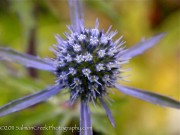
With silvered, narrow spiky ruffs that cradle metallic blue round flower heads, ‘Blaukappe’ makes a sterling addition to dried or fresh bouquets. The vividly colored “blue caps” crest stiff-branched, sturdy bluish stems arising from a handsome green basal rosette of coarsely toothed, rounded and leathery foliage. Let its fantastic mercury-hued accents temper the bronzed blades of Stipa arundinacea.
Blooms June–September.
Size: 2' 0" – 2-1/4' high x 18" wide.
Hardy to zone 4.
Eryngium planum ‘Blue Glitter’ (P-1446)
Each $11.25
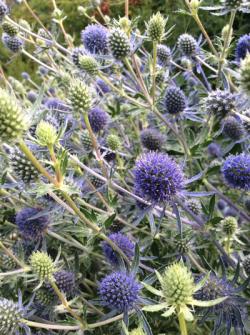
Pressing upward through fine saw-toothed, green succulent-like leaves, an abundance of multibranched pewter-blue stems yields some 85 ½ in. shimmering blue pincushions perched on spiny collars. This Ernst Benary selection promises to inspire gardeners and florists alike with a taller sturdy stature and profuse brilliantly colored blooms that mature quickly and make long lasting cut flowers.
Blooms July–September
Size: 2-1/2' – 3' 0" high x 12" – 18" wide.
Hardy to zone 5.
Eryngium planum ‘Blue Hobbit’ (P-0257)
Each $11.25
Though this adorable Sea Holly is brimming with cuteness and blue in a big way, its trim globular mound stays small. A dwarf compact rosette of toothed, thick dark green leaves unleashes stiff silver-blue stems and egg-shaped spiny purplish blue heads that appear in wondrous droves all summer long. True to its name and tenacious to boot, ‘Blue Hobbit’s diminutive bearing can be easily tucked into tight spots such as patio pots, between steps or atop stone walls.
Blooms June–September
Size: 8" – 12" high x 10" – 12" wide.
Hardy to zone 4.
Eryngium planum ‘Silver Salentino’ (P-1493)
Each $11.25
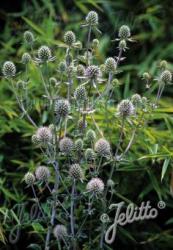
A snowy white multitude of plump conical flower heads perch atop pointed, widely spaced silver bracts. Leafy multibranching stems, pearly hued and steadfast, bolster the luminous blooms, while arising from an attractive dark green basal rosette defined by serrated leatherlike leaves and red-tinted petioles. Pair ‘Silver Salentino’ with Eryngium ‘Blue Glitter’ for a classic look.
Blooms July – September.
Size: 2-1/2' – 3' 0" high x 15" – 18" wide.
Hardy to zone 4.
Eryngium planum ‘White Glitter’ (P-2040)
Each $11.25

Lauded as the classy pearlescent twin to Eryngium ‘Blue Glitter’, this no-fuss, bee-friendly perennial affords a scintillating spectacle of dense egg-shaped white flowers with prominent, spiky pewter-colored bracts. The well-branched gray-green flowering stalks emerge from a neat, low growing globular mound forged by glossy, toothed dark green leaves. Pest-free ‘White Glitter’ handles dry conditions plus makes a long-lasting, luminous addition to containers, natural-type plantings or cottage gardens.
Blooms July–September
Size: 2' 0" – 3' 0" high x 8" – 10" wide.
Hardy to zone 5.
Eryngium proteiflorum (P-1179)
OUT OF PRODUCTION AT THIS TIME
Email me when this plant is available
An interesting combination of the prehistoric and the refined, this evergreen Eryngium is known for its large-coned, luminous flowers. Linear leaves emerge from a basal rosette with widely spaced spines along their margins. A dramatic collar of upturned, unequal steely green bracts, some reaching the striking breadth of 5 to 6 in. across, serves up central, sea-green flower heads reminiscent of a Protea. Ideal for dried arrangements, this exotic Mexican perennial demands a warm, sunny site with well drained, fertile soil. Give it a blue pot on the patio or another prominent location to bring its remarkable show in-to full view.
Blooms July–September.
Size: 2-1/2' – 3' 0" high x 2' 0" wide.
Hardy to zone 8.
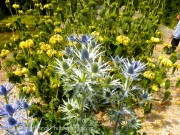
Distinguished from other Sea Hollies by the intense, steel-blue hue infusing its branched stems, upper leaves, and teasel-shaped flowers, ‘Sapphire Blue’ features huge blossoms nestled in dramatic collarlike bracts. With a stance that’s angular yet erect, this sturdy perennial makes a striking counterpoint to the downy white softness of Salvia argentea. (pp#11,088)
Blooms July – August.
Size: 2-1/4' high x 18" wide.
Hardy to zone 5.
Each $11.25
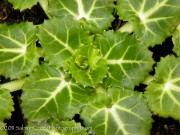
The Moroccan Sea Holly is as valuable for its unusual dark and evergreen marbled foliage as for its steel blue flowers set on spiny, silvery bracts atop thick, erect silver-blue stems. Smaller than other Eryngiums, Eryngium variifolium is well suited for an up-front position in the border, in a rock garden or in a container.
Blooms July–August.
Size: 18" high x 10" wide.
Hardy to zone 5.
Each $11.25
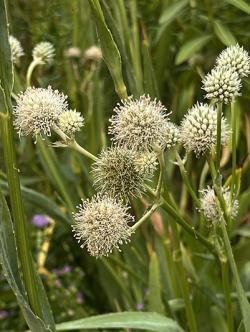
Smelling like a carrot, looking a bit like a Yucca and once used by pioneers and Native Americans as an antidote to rattlesnake venom, this American tall-grass prairie dweller brandishes bold, lax bluish green rosettes. Characterized by parallel veins, bristly edges and a glaucous finish, the 3 ft. long sword-shaped leaves launch a sculptural wonder of tight-set thistle-style greenish white spheres and pointed ivory bracts held within branched clusters on smooth stiff stems. A low-maintenance perennial that provides fantastic winter interest, Rattlesnake Master obliges dry rocky soil and looks compelling planted with Sesleria heufleriana or Pennisetum spathiolatum.
Blooms July–September
Size: 3' 0" – 4' 0" high x 18" – 2' 0" wide.
Hardy to zone 3.
Eryngium x zabelii ‘Donard Variety’ (P-2231)
Each $15.00
Presumably hailing from the famed Slieve Donard nursery, this valiant clump-forming perennial develops lustrous, toothed green rosettes, which shoulder erect branching stems topped with sensational soft-to-the-touch metallic-toned flowers. Prized by bees, butterflies and plant-lovers, the large thimble-style steel-hued heads are perched upon broad feathery ruffs of fine-hewn bluish gray bracts. ‘Donard Variety’ offers engaging winter interest, looks exceptional in fresh or dried arrangements, appreciates well-drained somewhat dry sites and makes a sensational partner for cohorts like Perovskia ‘Lacey Blue’ or Verbascum ‘Gainsborough’.
Blooms July–September
Size: 2' 0" – 3' 0" high x 15" – 18" wide.
Hardy to zone 5.
Stylish gleaming green leaves–thick, toothed and tattooed with prominent ivory-colored veins–uphold a fantastic architecture of staunch angular branched stems and extra large teasel-like flowers bathed in galvanizing bright blue hues. Brandishing long lasting late season blooms that honeybees cherish, ‘Jos Eijking’ is best suited for the front of an uncrowded bed, where its extraordinary bearing beguiles any visitor, even in wintertime.
Blooms July–September.
Size: 2' 0" high x 18" wide.
Hardy to zone 5.
Erysimum ‘Wenlock Beauty’ (P-1332)
Each $11.00
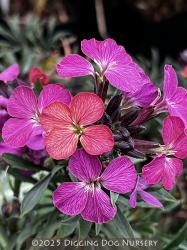
Evoking a lavish watercolor sunset, fragrant clustered 4-petaled blossoms on short stems initially showcase an array of charismatic colors, which include rose, violet and lavender shades, then later manifest mauve, orange, copper and dusky maroon tones. This compact low-growing AGM recipient sprouts an attractive mounding evergreen habit clothed with slim gray-green leaves beneath tight pinkish bronze buds and the pollinator-friendly flowers. Considered a subshrub and broccoli brethren, ‘Wenlock Beauty’ brings eye-catching charm to sun-drenched rock walls, well-drained perennial borders and cottage gardens, where it affords repeat blooms plus appreciates periodic cutbacks, but may be somewhat short-lived.
Blooms April–July
Size: 12" high x 18" wide.
Hardy to zone 5.
Erythronium
Fawn Lily
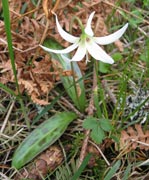
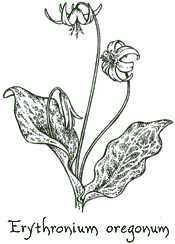
Some say it’s the mottled leaves resembling a fawn’s spotted back that evoke the common name, others think its the delicate thin stems and graceful flowers conjuring a young deer’s light-on-its-feet stance. Either way this demure Pacific northwest native is sure to please.
A lustrous base of broad, ripple-edged green and brown foliage stage numerous, nodding decorative “lanterns” on tall stems. Warmed by butter yellow centers, the elegant blooms spotlight creamy alabaster-colored petals whose slender, pointed tips curve back.
A vigorous, undemanding woodland bulb for carpeting the ground beneath a native shrub such as Ribes, the White Fawn Lily appreciates a deep planting in well drained soil and dry conditions once the clump disappears in June.
Blooms April.
Size: 8" high x 10" wide.
Hardy to zone 5.
Eucomis
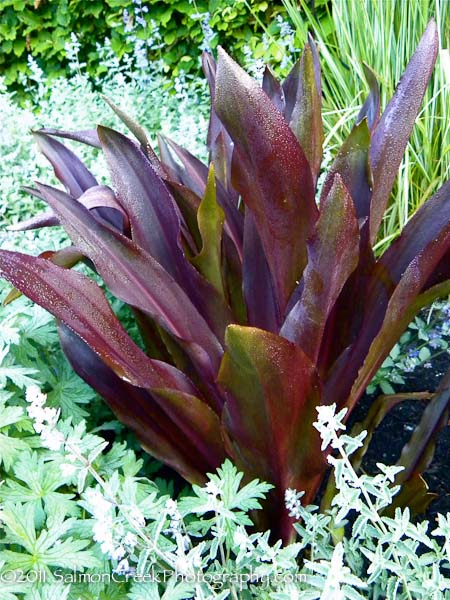
Pineapple Lily
A phenomenal display from a wondrous bulb, Eucomis belongs to the Lily family and calls tropical southern Africa its home. While its bold architectural lines beg a prominent spot in the ground or in a container, Pineapple Lily prefers warm, sunny nooks with mulched, well drained soil, and protection from excessive winter cold and moisture.

Anchored by lustrous, undulating light green leaves, maroon-flecked green stems elevate the intriguing purple-edged, pale green blooms. A tuft of verdant leaves crests each flowering raceme. Its smaller profile and out-of-the-ordinary coloration makes it an exemplary choice for a blue glazed vessel in a well traveled spot.
Blooms July–September.
Size: 18" – 2' 0" high x 2' 0" – 2-1/2' wide.
Hardy to zone 7.
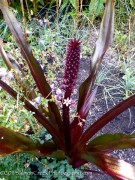
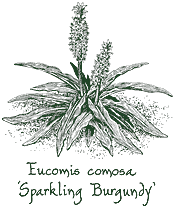
The sumptuous burgundy-red, semierect rosette of strapping, waxy leaves appears more green as the weather warms. Crowned by a pineapple-like cluster of leaves, densely set starry flowers envelope thick, cylindrical maroon spikes. The purple blossoms display unique greenish tones, and add dramatic, long lasting highlights to arrangements. Showy persistent seed capsules follow.
Blooms late July–September.
Size: 2' 0" – 2-1/2' high x 2-1/2' – 3' 0" wide.
Zone 7/8.

Massive deep ruby red spikes, densely studded with star-like milky pink flowers, ascend from a gorgeous upright rosette of thick vibrant burgundy straps. Tantalizing pollinators, horticulturists and florists, the long lasting blooms are crowned by pineapple-style clusters of small leaves, while showy persistent seed capsules extend the floral splendor. A sensational choice for a container, along a pathway or atop a rock wall, ‘Oakhurst’ flourishes in bright well-drained abodes, appreciates mulch (especially during cold winters) and endures drought, though it prefers moderate moisture.
Blooms July–September
Size: 2' 0" – 2-1/2' high x 18" – 2' 0" wide.
Hardy to zone 7.
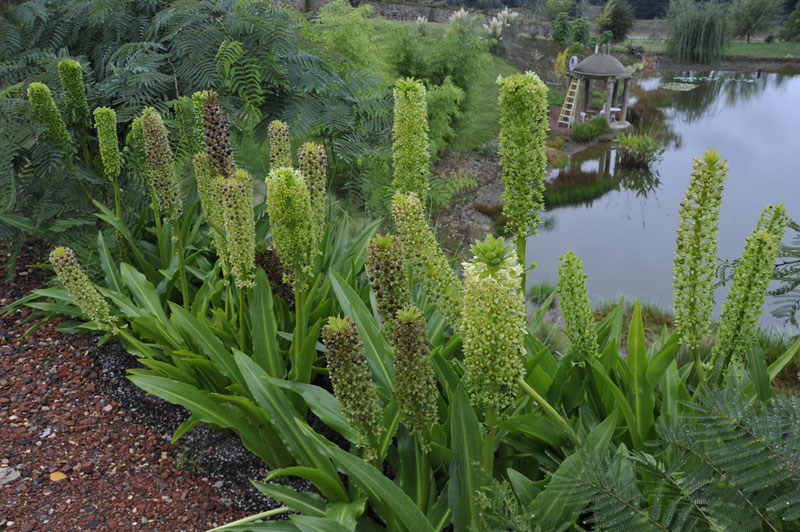
Welcome the Queen of Green! Succulent, waxed and wave-edged green leaves, sturdy green stalks, and a magnificent cluster of wide-open, bright green blooms blushed slightly with pink, are followed by a display of greenish fruits. Her genus name means “beautifully headed” and it describes the unusual leaf tuft that surmounts the cylindrical flower spike. Perhaps the tallest in her lineage, we suggest grouping several Eucomis together where people will linger so the distinctive flowers can be readily enjoyed.
Blooms July–October.
Size: 4' 0" – 5' 0" high x 3' 0" wide.
Hardy to zone 8.
Each $13.00
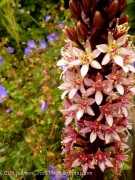
With bronzy merlot-colored undulating margins, the olive-green sword-like foliage shows off reddish toffee-shaded linear streaks on top, while curious burgundy stipples and striations mark the undersides. The warm-looking, somewhat erect rosette gets a cheerful lift when staunch flower stalks give way to pastel columns of star-shaped rosy pink flowers topped by leafy tufts.
Blooms late July–early October
Size: 2' 0" – 2-1/2' high x 2-1/2' – 3' 0" wide.
Zone 7/8.
Heightened by bronze overtones, curvy edges and streaked and speckled backsides, plus new burgundy growth, the 3 in. wide moss green straps reach nearly 2 ft. in length, sculpting a fantastic somewhat reflective roost. Beefy wine-hued stems uphold spectacular green tufted Pineapplesque towers that house a dense multitude of whitish flowers with prominent dusky violet centers. Companions such as Lepechinia hastata or Sedum ‘Jose Aubergine’, echo ‘Victoria’s opulent foliar shades and distinctive purple floral hues.
Blooms July–August
Size: 2-1/4' high x 3' 0" wide.
Zone 7/8.
Eupatorium
Joe-Pye Weed
Many have discovered the curative aspects of Eupatorium, yet only two have lent it their names: Eupator, a King of Pontus, and a Native American named Joe-Pye. We prescribe these undemanding perennials for whatever ails your garden. Some delegate this rather coarse and undeniably valiant member of the Asteraceae family to meadow gardens, but we’ve found that Eupatorium can provide balance and stability to formal situations as well. Best of all, butterflies love them!
Eupatorium maculatum ‘Glutball’ (P-2068)
OUT OF PRODUCTION AT THIS TIME
Email me when this plant is available
This coveted, tall-standing cultivar is named for its enormous, nearly ball-shaped umbels and warm glowing tones. Characterized by a hushed, easy-to-meld hue, the arresting plum-purple panicles surmount lustrous, straight-backed red stems. Dark green whorls of dashing, large, pointy serrated leaves with burgundy midribs clothe ‘Glutball’s grand frame that can be staged in borders or meadows, and added to floral arrangements, while wielding a majestic presence well into fall.
Blooms August–October
Size: 6' 0" – 7' 0" high x 3' 0" wide.
Hardy to zone 4.
Earning an AGM for its handsome, compact bushy habit and irresistible long-lasting floral spectacle, this easy-care late season bloomer touts a shorter more manageable height than its towering brethren. Durable upright purple-flecked stems garbed with whorled lance-like deep green leaves hoist the soft-looking broad domes of hushed rosy-purple flowers that are arranged in a looser, less snug fashion. Enjoyed by swallows, butterflies and numerous bee species, ‘Purple Bush’ creates splendid color echoes amongst Persicaria ‘Purple Spear’ and Veronicastrum ‘Cupid’.
Blooms August–September
Size: 4-1/2' – 5' 0" high x 2' 0" wide.
Hardy to zone 4.
Eupatorium maculatum ‘Riesenschirm’ (P-1754)
Each $12.75
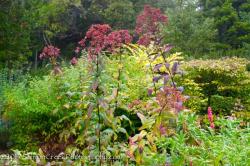
An AGM recipient, a magnet for bees and butterflies and one of the top 10 plants of the Dutch “wave,” this superb back-of-the-border beauty propels tall, polished, dark purple stems—stiff, straight and mighty—skyward bound. Loosely arranged whorls of heavily textured deep green tapered leaves anchor fluffy 8 in. wide domed flower heads awash with reddish purple hues. Its lofty architecture maintains a dignified profile, even in winter, enhanced by mulled brown shades and attractive seed heads, which nourish finches and tits.
Blooms August–October
Size: 5' 0" – 7' 0" high x 3' 0" wide.
Hardy to zone 4.
Each $12.00
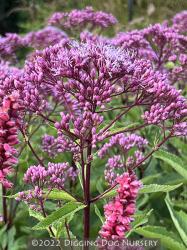
This robust cousin is from the taller side of the family (up to 6 or 7 ft.), and shares the wine red stem coloring of its smaller kin. Eupatorium purpureum features a stately carriage with broad, domed heads hosting purple-mauve flowers. It’s tough, reliable and effective for the back of the border.
Blooms September–October.
Size: 6' 0" high x 2' 0" wide.
Hardy to zone 4.
Eupatorium maculatum ‘Gateway’ (P-0067)
Each $12.75

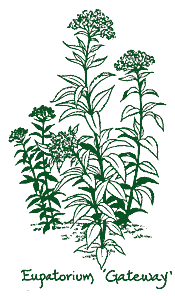
In late spring, ‘Gateway’s vigorous shoots burst through the mulch. Wine-colored stems develop large green coriaceous leaves, lending mass to the middle or rear of a mixed planting. Dense, broad flower clusters present a lavender-purple that’s both strong and soft. This uniquely muted color feels like fall and blends well with other late bloomers such as Rudbeckia or Aster ‘Bluebird’.
Blooms August–September
Size: 4' 0" high x 2' 0" wide.
Hardy to zone 4.
Eupatorium rugosum ‘Chocolate’ (P-0691)
Each $11.75
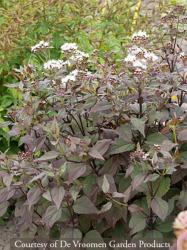
Sumptuous and shiny, crinkled reddish chocolate foliage adorns the erect purple stems of this standout cultivar, selected by Richard Lighty from the eastern native White Snakeroot. With Physocarpus ‘Dart’s Gold’ as a neighbor, Eupatorium ‘Chocolate’ adds rich accents to our mixed border, while in late summer, terminal corymbs of tiny white flowers seem to sparkle against the dark leaves.
Blooms August–September
Size: 4' 0" high x 2-1/2' wide.
Hardy to zone 4.
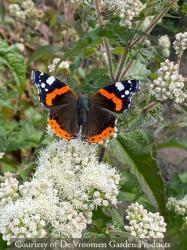
A selection from Piet Oudolf’s Hummelo Nursery, this energetic upright perennial champions large luminous domes shouldered by tall swarthy stems. Good-sized ovate green leaves garb the attractive compact habit beneath a generous late-season parade of ivory-white flowers that bees and butterflies fancy. Happiest in moist soil with protection from hot afternoon sun, ‘Snowball’ glitters against a dark backdrop, lending lively highlights to sizable cohorts such as Helianthus ‘Gold Lace’ and Aster ‘Nachauge. (pp#22,869)
Blooms August–October
Size: 4' 0" – 4-1/2' high x 2-1/2' – 3' 0" wide.
Hardy to zone 4.
Eupatorium
Joe-Pye Weed
Many have discovered the curative aspects of Eupatorium, yet only two have lent it their names: Eupator, a King of Pontus, and an American Indian named Joe-Pye. We prescribe these undemanding perennials for whatever ails your garden. Some delegate this rather coarse and undeniably valiant member of the Asteraceae family to meadow gardens, but we’ve found that Eupatorium can provide balance and stability to formal situations as well. Best of all, butterflies love them!
Eupatorium maculatum ‘Glutball’ (P-2068)
OUT OF PRODUCTION AT THIS TIME
Email me when this plant is available
This coveted, tall-standing cultivar is named for its enormous, nearly ball-shaped umbels and warm glowing tones. Characterized by a hushed, easy-to-meld hue, the arresting plum-purple panicles surmount lustrous, straight-backed red stems. Dark green whorls of dashing, large, pointy serrated leaves with burgundy midribs clothe ‘Glutball’s grand frame that can be staged in borders or meadows, and added to floral arrangements, while wielding a majestic presence well into fall.
Blooms August–October
Size: 6' 0" – 7' 0" high x 3' 0" wide.
Hardy to zone 4.
Earning an AGM for its handsome, compact bushy habit and irresistible long-lasting floral spectacle, this easy-care late season bloomer touts a shorter more manageable height than its towering brethren. Durable upright purple-flecked stems garbed with whorled lance-like deep green leaves hoist the soft-looking broad domes of hushed rosy-purple flowers that are arranged in a looser, less snug fashion. Enjoyed by swallows, butterflies and numerous bee species, ‘Purple Bush’ creates splendid color echoes amongst Persicaria ‘Purple Spear’ and Veronicastrum ‘Cupid’.
Blooms August–September
Size: 4-1/2' – 5' 0" high x 2' 0" wide.
Hardy to zone 4.
Eupatorium maculatum ‘Riesenschirm’ (P-1754)
Each $12.75

An AGM recipient, a magnet for bees and butterflies and one of the top 10 plants of the Dutch “wave,” this superb back-of-the-border beauty propels tall, polished, dark purple stems—stiff, straight and mighty—skyward bound. Loosely arranged whorls of heavily textured deep green tapered leaves anchor fluffy 8 in. wide domed flower heads awash with reddish purple hues. Its lofty architecture maintains a dignified profile, even in winter, enhanced by mulled brown shades and attractive seed heads, which nourish finches and tits.
Blooms August–October
Size: 5' 0" – 7' 0" high x 3' 0" wide.
Hardy to zone 4.
Each $12.00

This robust cousin is from the taller side of the family (up to 6 or 7 ft.), and shares the wine red stem coloring of its smaller kin. Eupatorium purpureum features a stately carriage with broad, domed heads hosting purple-mauve flowers. It’s tough, reliable and effective for the back of the border.
Blooms September–October.
Size: 6' 0" high x 2' 0" wide.
Hardy to zone 4.
Eupatorium maculatum ‘Gateway’ (P-0067)
Each $12.75


In late spring, ‘Gateway’s vigorous shoots burst through the mulch. Wine-colored stems develop large green coriaceous leaves, lending mass to the middle or rear of a mixed planting. Dense, broad flower clusters present a lavender-purple that’s both strong and soft. This uniquely muted color feels like fall and blends well with other late bloomers such as Rudbeckia or Aster ‘Bluebird’.
Blooms August–September
Size: 4' 0" high x 2' 0" wide.
Hardy to zone 4.
Eupatorium rugosum ‘Chocolate’ (P-0691)
Each $11.75

Sumptuous and shiny, crinkled reddish chocolate foliage adorns the erect purple stems of this standout cultivar, selected by Richard Lighty from the eastern native White Snakeroot. With Physocarpus ‘Dart’s Gold’ as a neighbor, Eupatorium ‘Chocolate’ adds rich accents to our mixed border, while in late summer, terminal corymbs of tiny white flowers seem to sparkle against the dark leaves.
Blooms August–September
Size: 4' 0" high x 2-1/2' wide.
Hardy to zone 4.

A selection from Piet Oudolf’s Hummelo Nursery, this energetic upright perennial champions large luminous domes shouldered by tall swarthy stems. Good-sized ovate green leaves garb the attractive compact habit beneath a generous late-season parade of ivory-white flowers that bees and butterflies fancy. Happiest in moist soil with protection from hot afternoon sun, ‘Snowball’ glitters against a dark backdrop, lending lively highlights to sizable cohorts such as Helianthus ‘Gold Lace’ and Aster ‘Nachauge. (pp#22,869)
Blooms August–October
Size: 4' 0" – 4-1/2' high x 2-1/2' – 3' 0" wide.
Hardy to zone 4.
Euphorbia
Milkwort
Named after Euphorbus, physician to the king of Mauritania, this robust, sun-loving genus includes the familiar Poinsettia and is over 1600 species strong. Most Euphorbia have a poisonous milky sap and soft-colored bracts that surround subtly defined flowers. Autumn watches many of their narrow green leaves turn shades of red, orange and yellow.
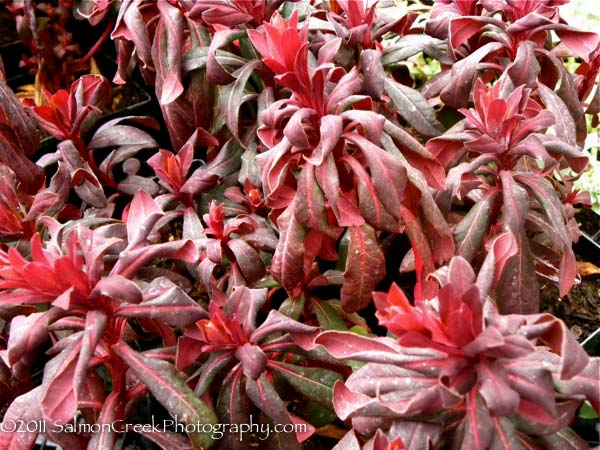
A gorgeous medley of deep burgundy, bronzy maroon and ruby red suffuses this Euphorbia's head turning foliage. Cresting a well-groomed base defined by plush evergreen leaves and sturdy stems, plentiful ebullient chartreuse blooms provide vivid contrast. Compact, hardy and downright irresistible ‘Ruby Glow’ can be nestled near the front of the border, along a pathway or showcased in a patio container. (uspp#22,200)
Blooms March–May.
Size: 12" – 18" high x 18" wide.
Hardy to zone 6.
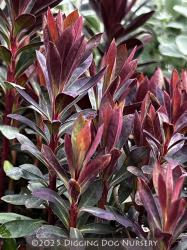
Chanced upon at Notcutts Nursery in England, this gold medal-winning ‘Redwing’ sport premiers plentiful lemon-lime colored flowers accompanied by a dramatic dose of red-imbued new growth and stems, plus elliptical dark burgundy and purple mature leaves. Tailored, well-branched and thickset, the bushy undemanding habit graces containers, mixed borders or rock gardens with velvet-like allure, while abiding deer and shallow rocky soil as well as periodic dry conditions. ‘Blackbird’ retains its evergreen good looks year round in warmer locales. (pp#17,178)
Blooms May–June
Size: 12" – 2' 0" high x 12" – 2' 0" wide.
Hardy to zone 6.
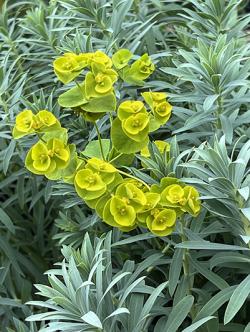
This choice Euphorbia hybrid between nicaeensis and seguieriana ssp. niciciana should make its way into more gardens. Crowned by yellow-green flower heads, attractive, blue-gray linear foliage is densely arranged, forming a compact and bushy evergreen mound. Cistus ‘Grayswood Pink’ and Thymus ‘Archer’s Gold’ bring contrasting accents to its pale pointed leaves and glowing blooms.
Blooms July–September
Size: 18" high x 2' 0" wide.
Hardy to zone 5.
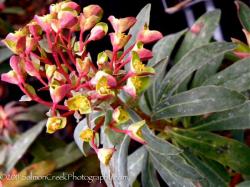
A standout for its wine-colored new growth, bronzy purple foliage with red-hued leaf undersides and stocky red stems, this robust, low growing wulfenii hybrid boasts large, cylindrical, golden yellow flower heads. Try planting in a mixed border with Cistus ‘Snow White’ and Cynoglossum nervosum for spectacular concurrent blooms.
Blooms April–late July.
Size: 2-1/2' high x 3' 0" wide.
Hardy to zone 7.
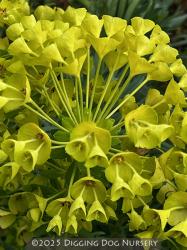
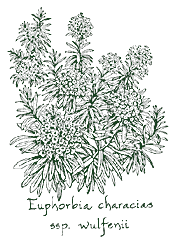
Distinctive and drought tolerant, this Euphorbia deserves to be used as a specimen. Its rounded flower heads are chartreuse, reaching 6 to 9 in. across and 9 in. high. Combine with Epilobium ‘Everett’s Choice’ plus bronzed Carex tenuiculmis, and enjoy the dramatic array of color and texture.
Blooms March–June
Size: 3' 0" – 5' 0" high x 3' 0" – 4' 0" wide.
Hardy to zone 7.
Topped with the same voluminous chartreuse flower heads as Euphorbia characias, this dapper lower-growing cultivar develops a more closely-knit bush-like habit. Stout upright stems are wrapped in slender gray-green leaves that keep the deer at bay and offer year-round allure. ‘Bruce’s Dwarf’ can festoon a stone wall or take a border’s front-row seat, where its grandiose day-glow blooms can be positioned near Geranium ‘Johnson’s Blue’ for a riveting spectacle.
Blooms March–early July
Size: 2' 0" – 3' 0" high x 2' 0" – 3' 0" wide.
Hardy to zone 7.

A selection made from wild seed collected in the former Yugoslavia by the namesake, this charismatic Euphorbia is esteemed for its handsome compact profile and glowing yellow-green conical inflorescences. Large rounded and broad heads taper towards the base while housing crowded bell-shaped flowers.
With color that promises to exhilarate, ‘John Tomlinson’ unites swirls of waxy blue-gray leaves on green stems beneath dazzling, sunshine-bright blooms alongside warm-hued Isoplexis canariensis in our mixed border.
Blooms March–June.
Size: 3' 0" – 4' 0" high x 3' 0" – 4' 0" wide.
Hardy to zone 7.
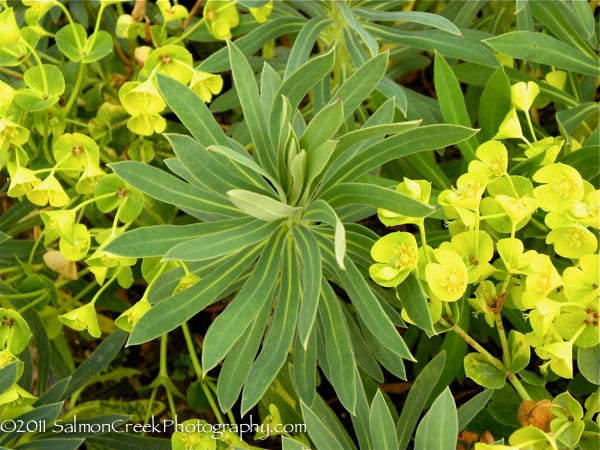
This show-stopping spurge was bred into being by the late plantswoman Margery Fish. Large, glowingly yellow blooms have a bright canary chroma that competes with the sun. Broad and bushy, its compact forest of erect stems is lined with slender gray-green leaves, relaxing downward in graceful arcs.
Blooms March–early July
Size: 3-1/2' high x 3-1/2' – 4' 0" wide.
Hardy to zone 7.
Euphorbia characias ‘Red Wing’ (P-1106)
Each $11.75
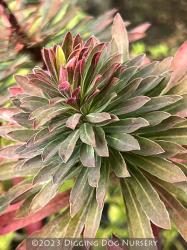
Perhaps more muted in color than a cardinal’s wing but still as captivating, this new cultivar is enlivened with red-tinged young growth and red floral buds held by reddish stems. All this rubescent coloring richly complements the handsome dark green foliage, and in late winter the profusion of electric yellow-green bracts set its compact form aglow. Appealing year round, ‘Red Wing’ can be paired with Helianthemum.
Blooms late March–May
Size: 20" – 2' 0" high x 2' 0" wide.
Hardy to zone 5.
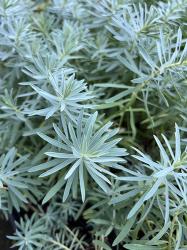
Honoring plantsman Kent Copton, who developed both a garden and a nursery in Faversham, England, this well-groomed shrubby Euphorbia produces finely hewn cool bluish green foliage and billowing masses of lime-green flowers in an endless summer procession. Compared to E. ‘Dean’s Hybrid’ or E. ‘Blue Haze’, its needle-like linear leaves are longer, while its larger semievergreen mound surpasses E. ‘Limewall’s. For a lovely floral pairing, ‘Copton Ash’ can be planted with Geranium sanguineum var. lancastriense along a pathway, amidst rock work or in a planter.
Blooms May–October
Size: 2' 0" high x 2' 0" wide.
Hardy to zone 7.
Euphorbia ‘Dean’s Hybrid’ (P-1337)
Each $11.75
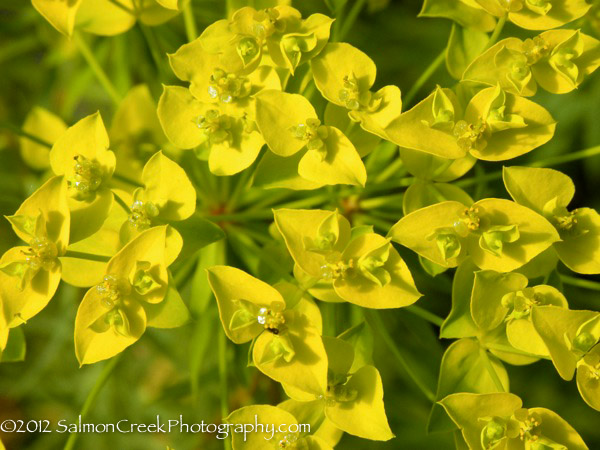
We have Dean Dalton of Occidental, California to thank for discovering this brilliantly colored, marathon blooming Euphorbia. Electrifying billows painted in acid yellows envelope a dense green globelike mound of fine textured narrow foliage.
First staged in spring, followed by a rebloom from summer until nearly winter, the fantastic floral show eventually attains orange hues, further heightening its low growing understory. In addition to his untiring floriferous nature, ‘Dean’s Hybrid’ maintains a well mannered, carefree profile that looks downright extraordinary as a container subject, spotlighted atop a wall or by a staircase.
Blooms April & September–October.
Size: 18" – 2' 0" high x 2' 0" wide.
Hardy to zone 7.
Dwelling above 5000 ft. throughout the eastern Himalayas in forest clearings and grazed hillsides, this superb robust species sports olive-green foliage with a springtime rubescent blush and distinctive milky white midribs. Staunch, red-imbued clumping stems bolster summer blooming lime-yellow inflorescences. We spotted this unique form of Euphorbia donii at Christopher Lloyd’s Great Dixter years ago and have since enjoyed its cool-colored bracts swaying amid Sanguisorba ‘Red Thunder’ in our own garden.
Blooms June – October.
Size: 5' 0" high x 4' 0" wide.
Hardy to zone 5.
Euphorbia ‘Excalibur’ (P-0743)
Each $11.75
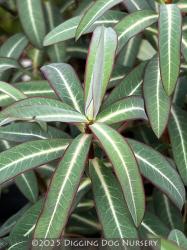
Rallying exceptional three season appeal, this regal British Euphorbia is most likely a hybrid between Euphorbia cornigera and Euphorbia schillingii. Sumptuous red-tinted young shoots enhance the mature green leaves that don prominent creamy midribs plus fine-drawn plush burgundy margins. Crowned by long-lasting flowers with greenish yellow bracts, ‘Excalibur’s erect habit flushes crimson for a snazzy fall finale and remains evergreen in milder climates.
Blooms June–August
Size: 3' 0" high x 15" – 2' 0" wide.
Hardy to zone 5.
Warm colors radiate from this vigorous seedling selection by Clive Jones, named in honor of the house he was living in at the time. Bronzy pink tips, colorful reddish stems and leaf margins, burnt orange flower bracts and magnificent fall color give ‘Fern Cottage’ a cheerful rosy glow through most of the season.
Blooms March–July.
Size: 3' 0" – 3-1/2' high x 2' 0" & spreading wide.
Hardy to zone 6.
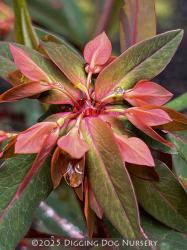
This bold native of the Himalayas and western Asia warms any rock garden and makes a magnificent companion to Corydalis f. ‘Blue Panda’ and Kerria ‘Albiflora’. ‘Fireglow’s flame orange bracts and brick-colored flowers stand torchlike on strong pomegranate red stems, and its soft green foliage blushes crimson and yellow in the fall.
Blooms April?July.
Size: 3' 0" high x 2' 0" & spreading wide.
Hardy to zone 6.
Euphorbia griffithii ‘Great Dixter’ (P-1232)
Each $12.50

The late renowned garden writer Christopher Lloyd, selected this superb Euphorbia for its sumptuous display of fiery hues. Debuting purple-tinged coral shoots, reddish bronze stems, dark green foliage flushed with copper-red tints and burnt apricot-pink blooms, ‘Great Dixter’ seldom experiences a lackluster moment. The unforgettable radiance that emanates from this compact griffithii can be shown to great effect next to Kniphofia ‘Bee’s Sunset’.
Blooms April–July
Size: 2' 0" – 3' 0" high x 2' 0" & spreading wide.
Hardy to zone 6.
Euphorbia ‘Helen Robinson’ (P-0849)
OUT OF PRODUCTION AT THIS TIME
Email me when this plant is available
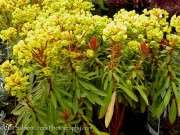
From the robbiae side of the family, this choice, stalwart Euphorbia inherits its compact stature, shade tolerance, and handsome, stout rosettes of blunt-tipped, dark green leaves; the characias side contributes the good-sized chartreuse flower heads. In our garden, it acccompanies Anchusa with a carpet of Corydalis ‘Pere David’ skirting beneath.
Blooms April–mid-July.
Size: 2-1/2' high x 3' 0" wide.
Hardy to zone 7.
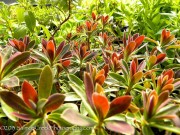
Evoking images of viridescent dragon scales, pointed blue-green leaves create a compact deer-proof assemblage that’s infused with reddish purple tinges. This tidy-looking robust Milkwort shoulders summer-blooming chartreuse flower heads nearly one foot across. Consorts such as Panicum ‘Shenandoah’ and Eupatorium ‘Gateway’ accentuate its colorful hues.
Blooms July–October
Size: 2' 0" – 2-1/2' high x 3' 0" wide.
Zone 6/7.
Each $11.75
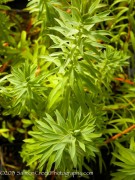
Small, whorled linear leaves, bathed in tranquil bluish celadon hues, are pointed and narrow, yet slightly broader and not as closely arranged as those of ‘Dean’s Hybrid’. A long lasting day glow display of bright lime-green flower heads and wine-infused older stems bring dramatic elements to the low tailored evergreen mound that needs minimal water and braves the deer. Grateful for a well-drained niche, ‘Limewall’s effulgent blooms enliven perennials such as Saponaria ‘Max Frei’ and Origanum libanoticum.
Blooms May–October.
Size: 12" high x 2' 0" wide.
Hardy to zone 7.
Native to the mountain meadows and forest clearings of the Himalayas, this vigorous species is most notable for its upright stature and beautiful foliage, highlighted with white midveins and pinkish margins. Along with its big and bright chartreuse flowers, these colors make for a lovely combination with Nepeta ‘Pool Bank’, Miscanthus ‘Malepartus’ and Aster ‘Mönch’ in the perennial border.
Blooms mid-May – September.
Size: 4' 0" – 5' 0" high x 3' 0" – 4' 0" wide.
Hardy to zone 6.
Each $11.75

A well-loved garden mainstay since the late 1800s, this naturally occurring evergreen hybrid between Euphorbia amygdaloides and Euphorbia characias was discovered in France. Stiff upright stems plus narrow lance-shaped ash-green leaves define the dapper compact mound that bolsters voluminous dense terminal cymes with burgundy-centered lime-yellow bracts. Equally at ease in traditional borders or more modern venues, Euphorbia x martini′s hardy subshrub-like habit toughs coastal sites, dry conditions, lean soil and deer, while its zingy long-lasting flowers, purple-tinged new growth and red-stained winter-time stalks afford vivacious multiseason allure.
Blooms March–June
Size: 2' 0" high x 2' 0" wide.
Hardy to zone 6.
Each $12.00

We first saw this evergreen Euphorbia at Sissinghurst; its native home is the Canary Islands. Shrub-like and taller than its relatives, its smooth green stems are clothed with narrow, whorled apple-green leaves marked by prominent cream-hued midribs. The "honey-bearing" epithet foretells the ambrosial aroma of the intriguing flowers, which range in color from butter to terracotta. Stately in a container, is not reliably hardy where winters are cold and wet.
Blooms June–October
Size: 5' 0" – 7' 10" high x 3-2/3' – 5' 0" wide.
Zone 5/6.
Each $11.75
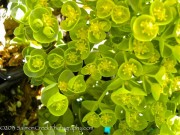
Waxed silvery-blue evergreen leaves held in succulent spirals make this stalwart perennial appear otherworldly. In midwinter, its thick trailing stems grow upward, fashioning an 8 in. tall base for the starry, lime-green flowers and lemon-yellow bracts, which form large brilliant clusters, highlighted with pinkish streaks. A Eurasian native undaunted by cold, heat or drought, Euphorbia myrsinites brings an exotic touch to a well-drained site in the rockery or atop a dry stone wall.
Blooms April–June
Size: 15" high x 2' 0" wide.
Zone 5/6.
Euphorbia polychroma ‘Candy’ (P-0748)
Each $11.75
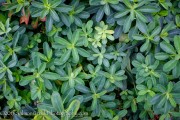
The sweet melding of purplish new spring tips amid narrow blue-tinged green leaves with ripple-edged margins plus flashy sulphur-yellow bracts distinguishes ‘Candy’s neat low-growing mound. A delectable addition to borders, rock walls and pathways, this carefree long-lived Euphorbia flaunts enticing rosy-red fall color, relishes dry well-drained nooks and tolerates poor soil.
Blooms February–May
Size: 12" – 15" high x 2-1/2' wide.
Zone 4b/5.
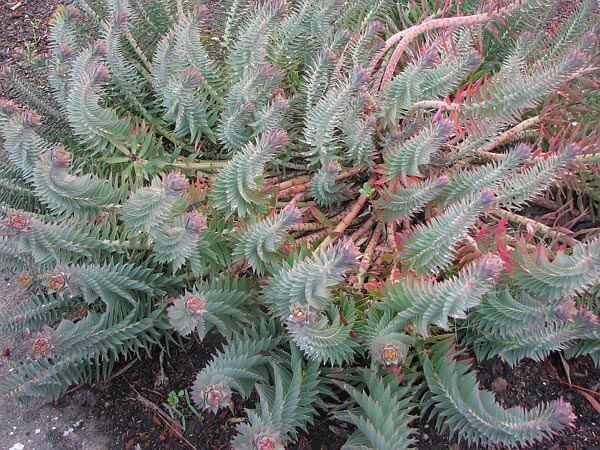
Beware! The sculptural patterns created by these sharply pointed, powder blue, narrow leaves clasping pale green stems may leave you feeling mesmerized. Warmed with burgundy tinges as the weather cools, the fleshy, evergreen foliage bolsters acid green, rounded flower heads that remind us of miniature poinsettia blooms.
Claiming the Mediterranean from Portugal to South Africa as its homeland, this easy-to-grow toughie asks only for a dry, sunny spot, and in turn promises superb winter color in a container or in the garden amid small bulbs and Agave ‘Garland’s Gold’.
Blooms April–June.
Size: 18" – 2' 0" high x 2' 0" wide.
Zone 7/8.
Euphorbia sikkimensis (P-0401)
OUT OF PRODUCTION AT THIS TIME
Email me when this plant is available
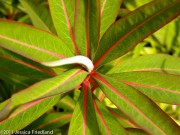
An Eastern Himalayan inhabitant, this summer blooming Euphorbia has young reddish shoots and a lovely pink cast to its new leaves. Mature foliage is large and apple green with a creamy pink midrib, while thick, upright reddish stems slowly spread, supporting the lime-green flowers without staking.
The Sikkim Spurge provides architectural interest and alluring foliar contrast when it flanks broad-leafed Salvia prezwalskii.
Blooms July – September.
Size: 4' 0" high x 2' 0" wide.
Hardy to zone 6.









